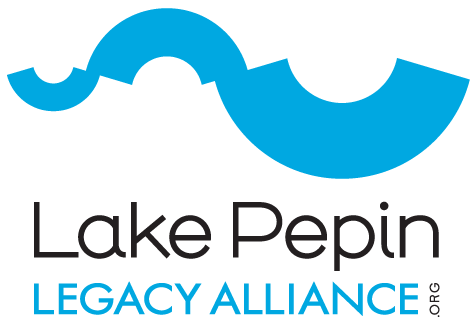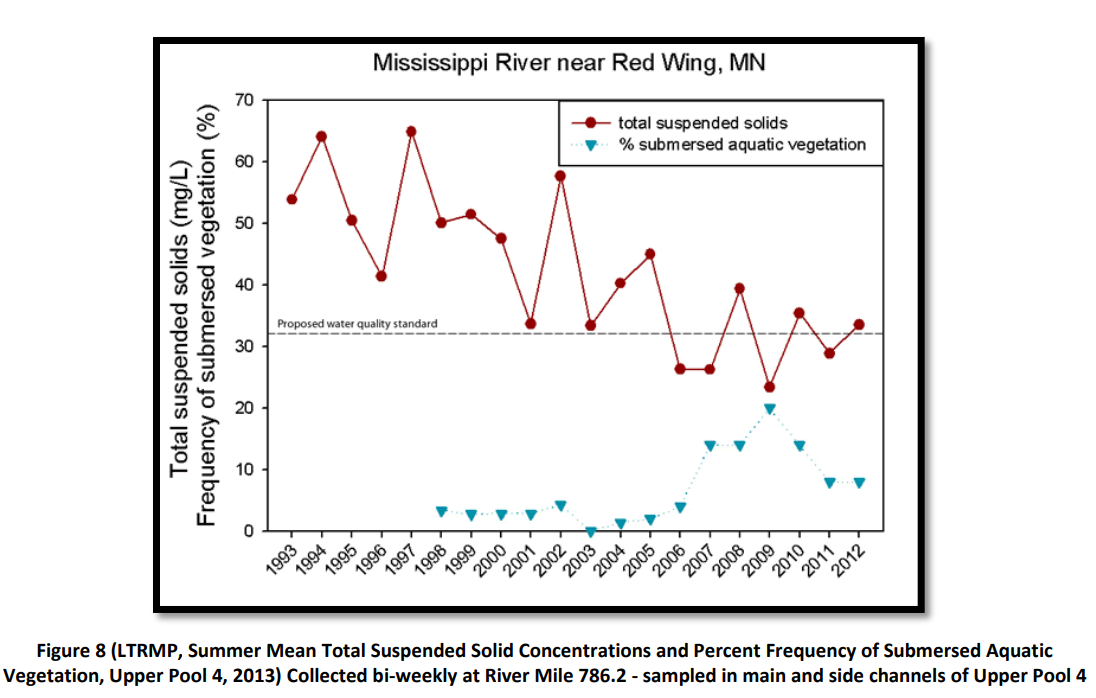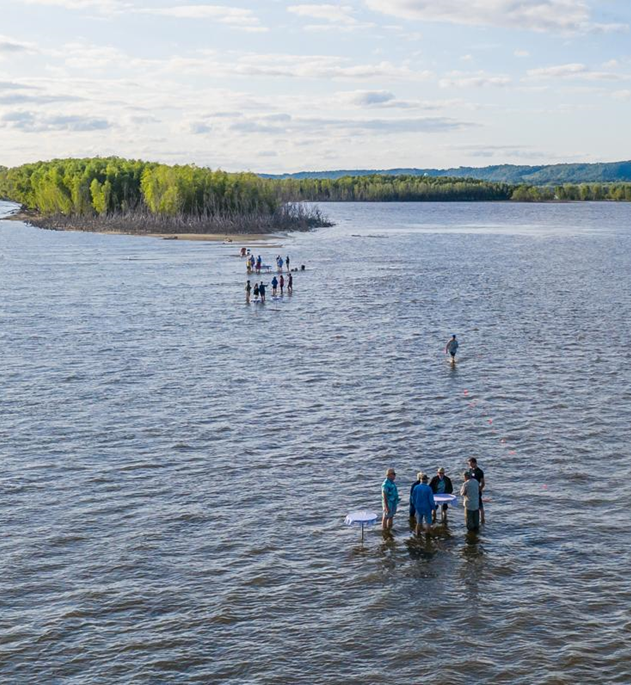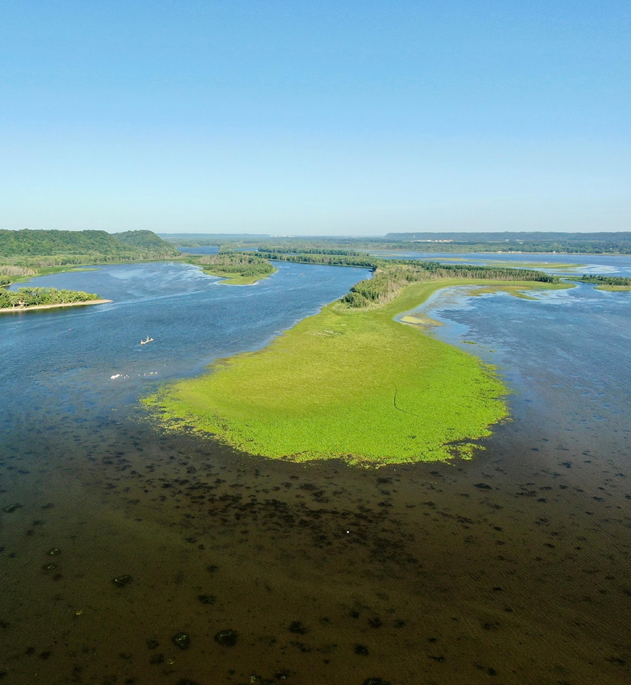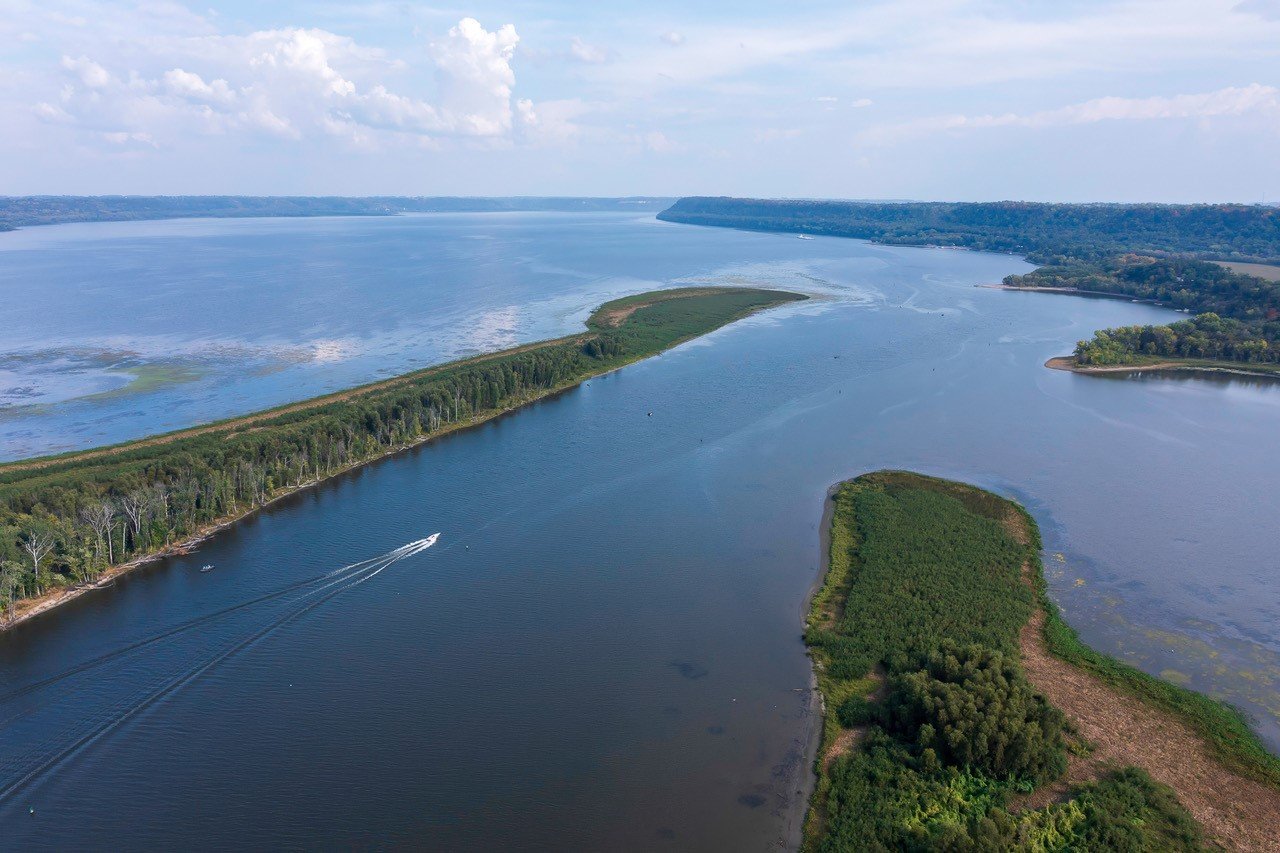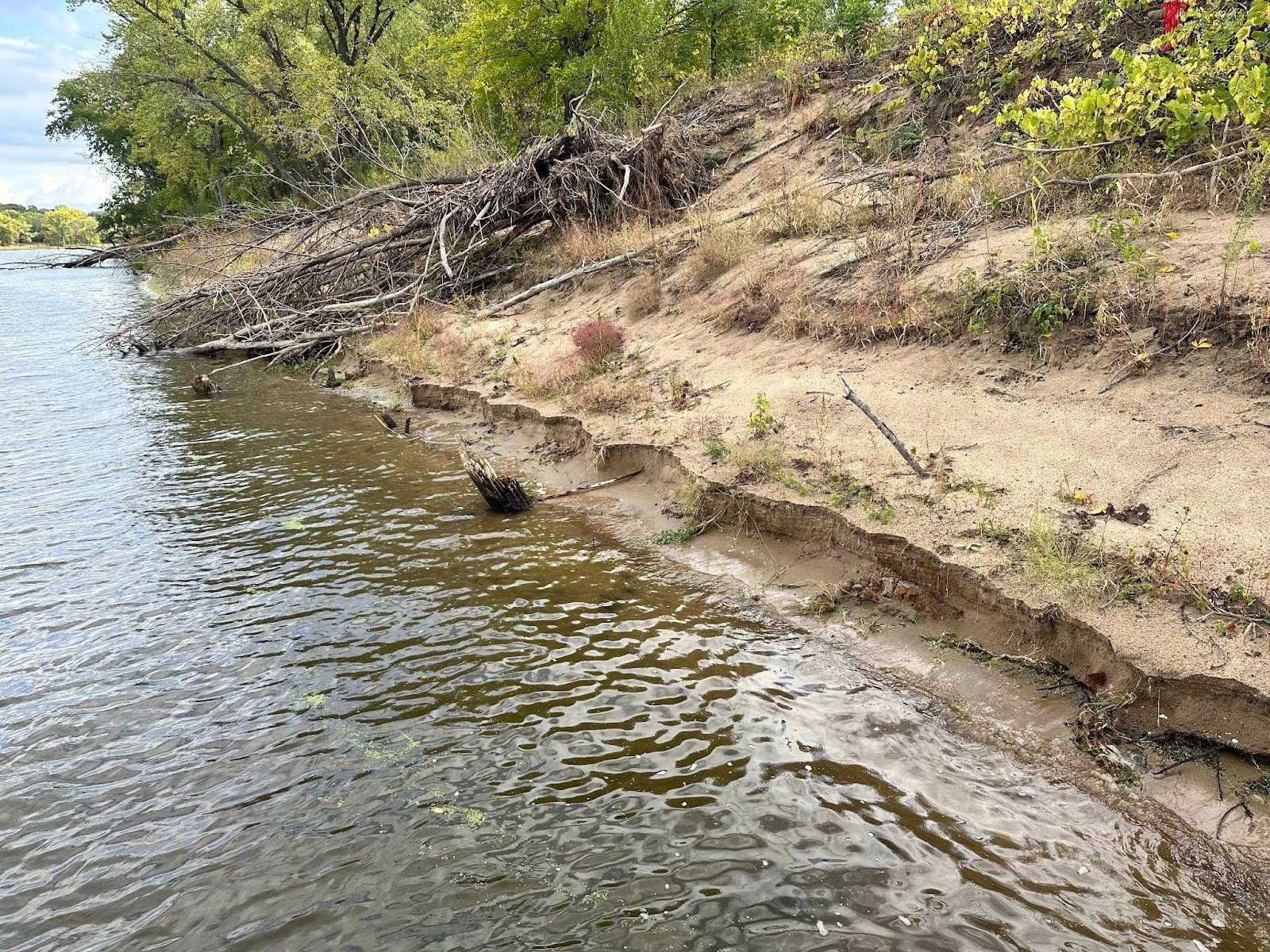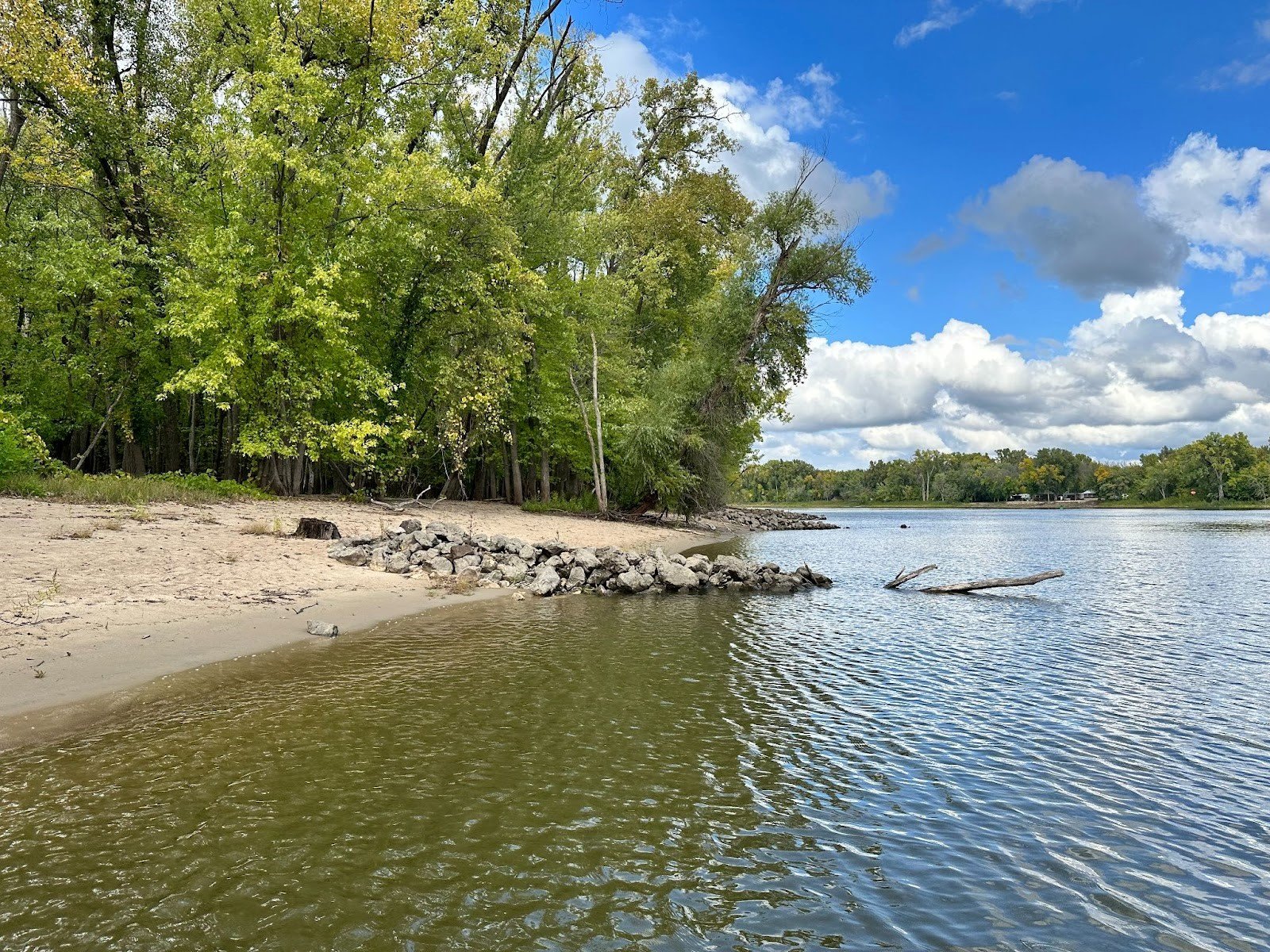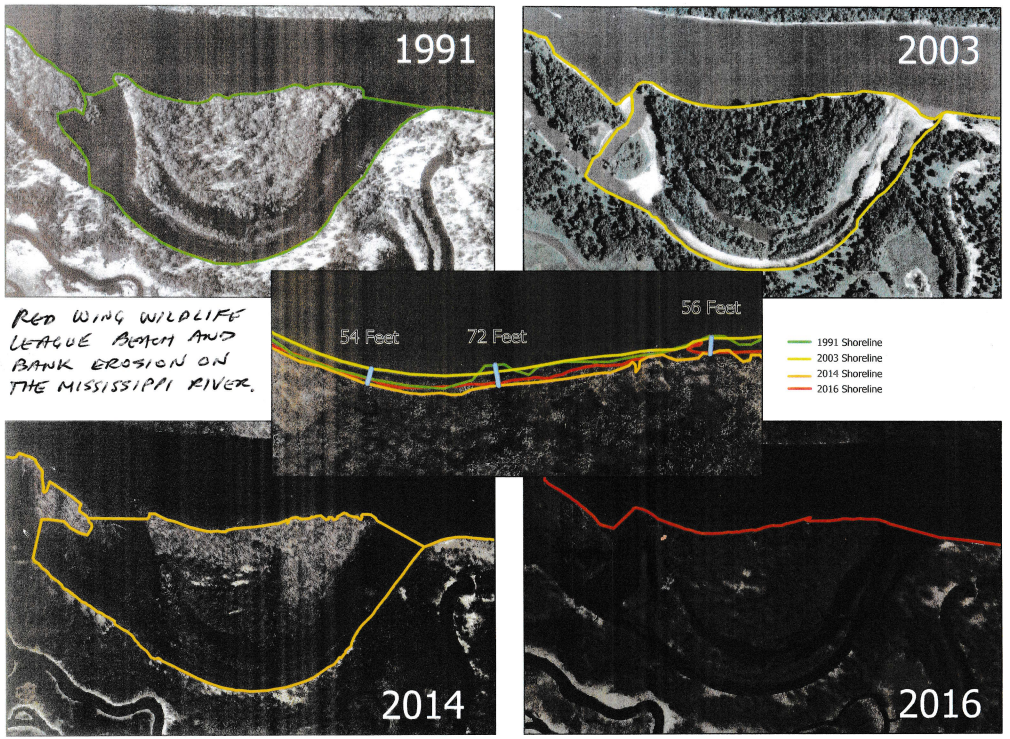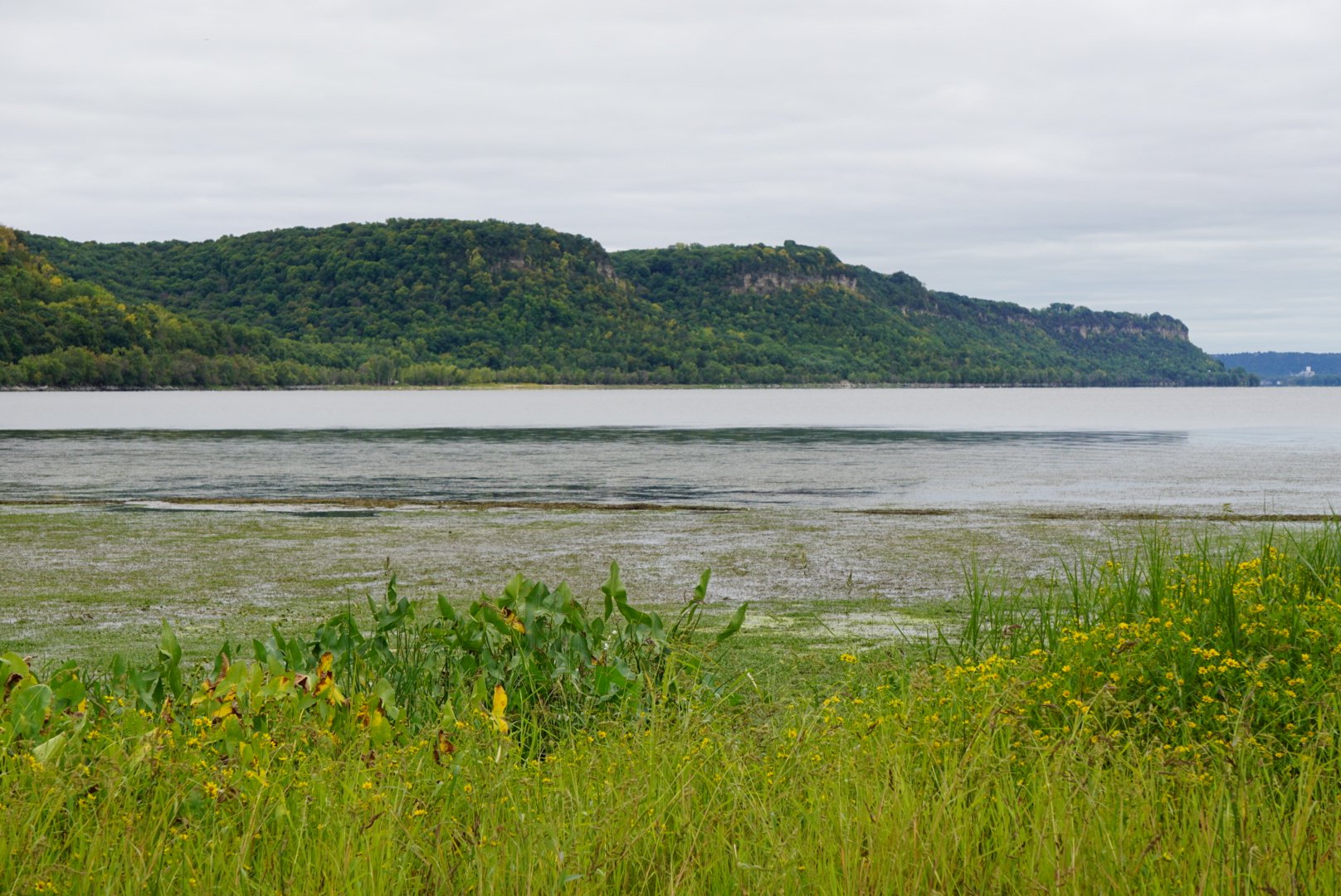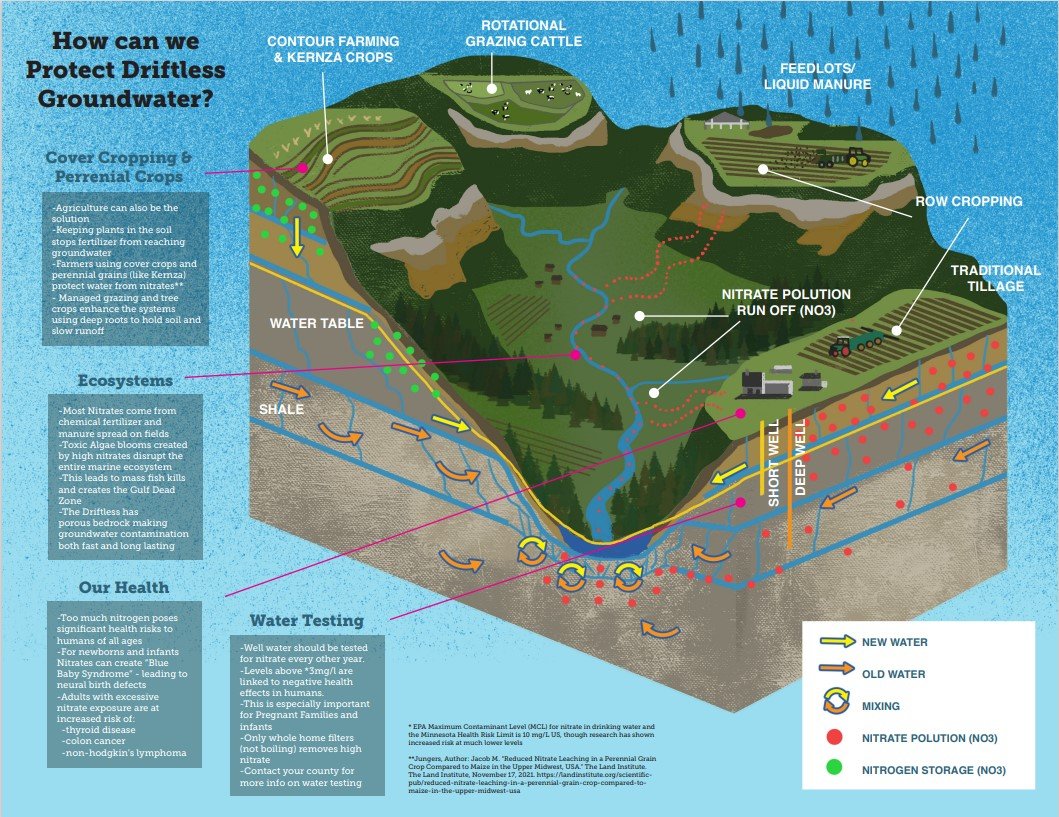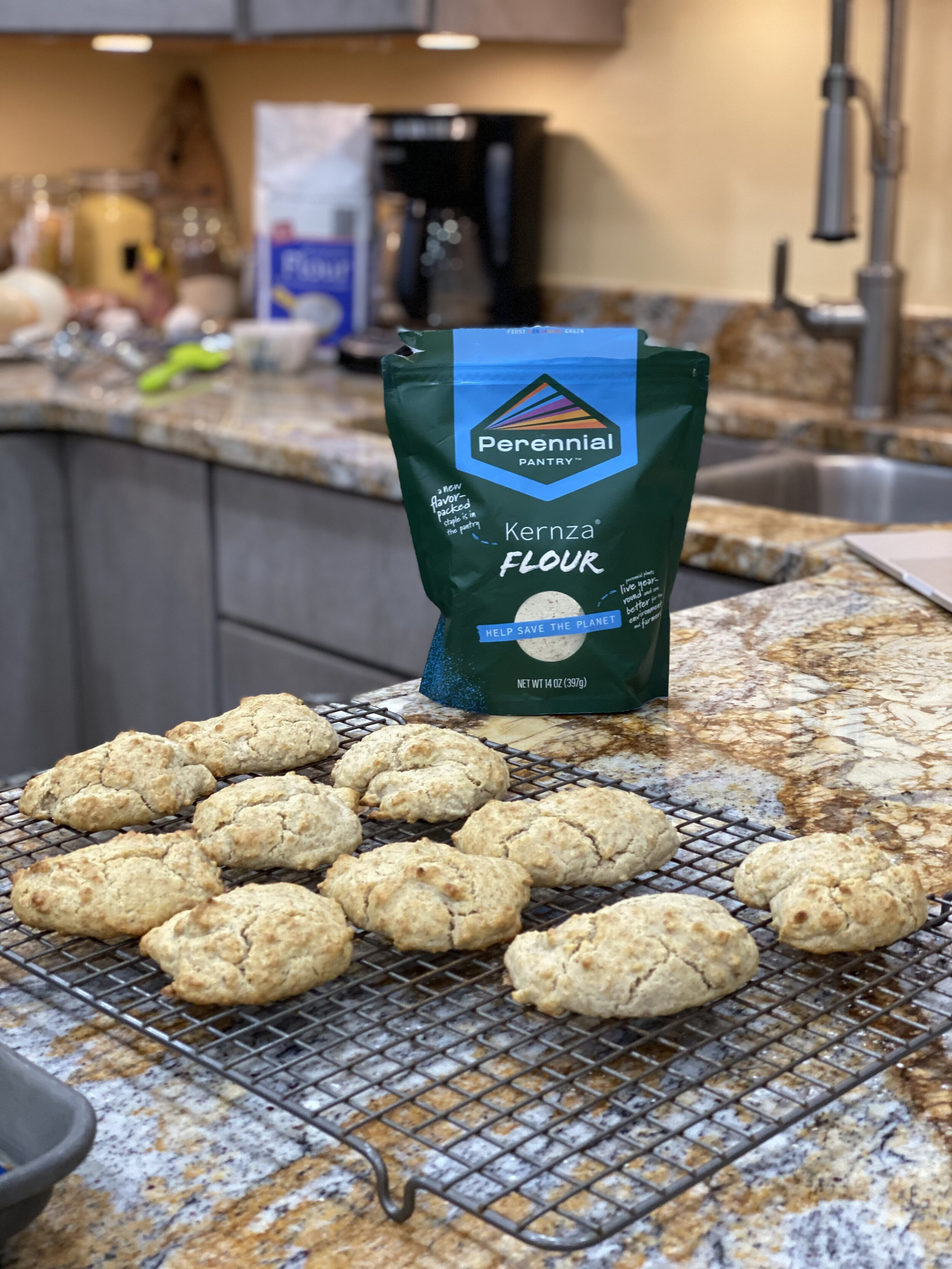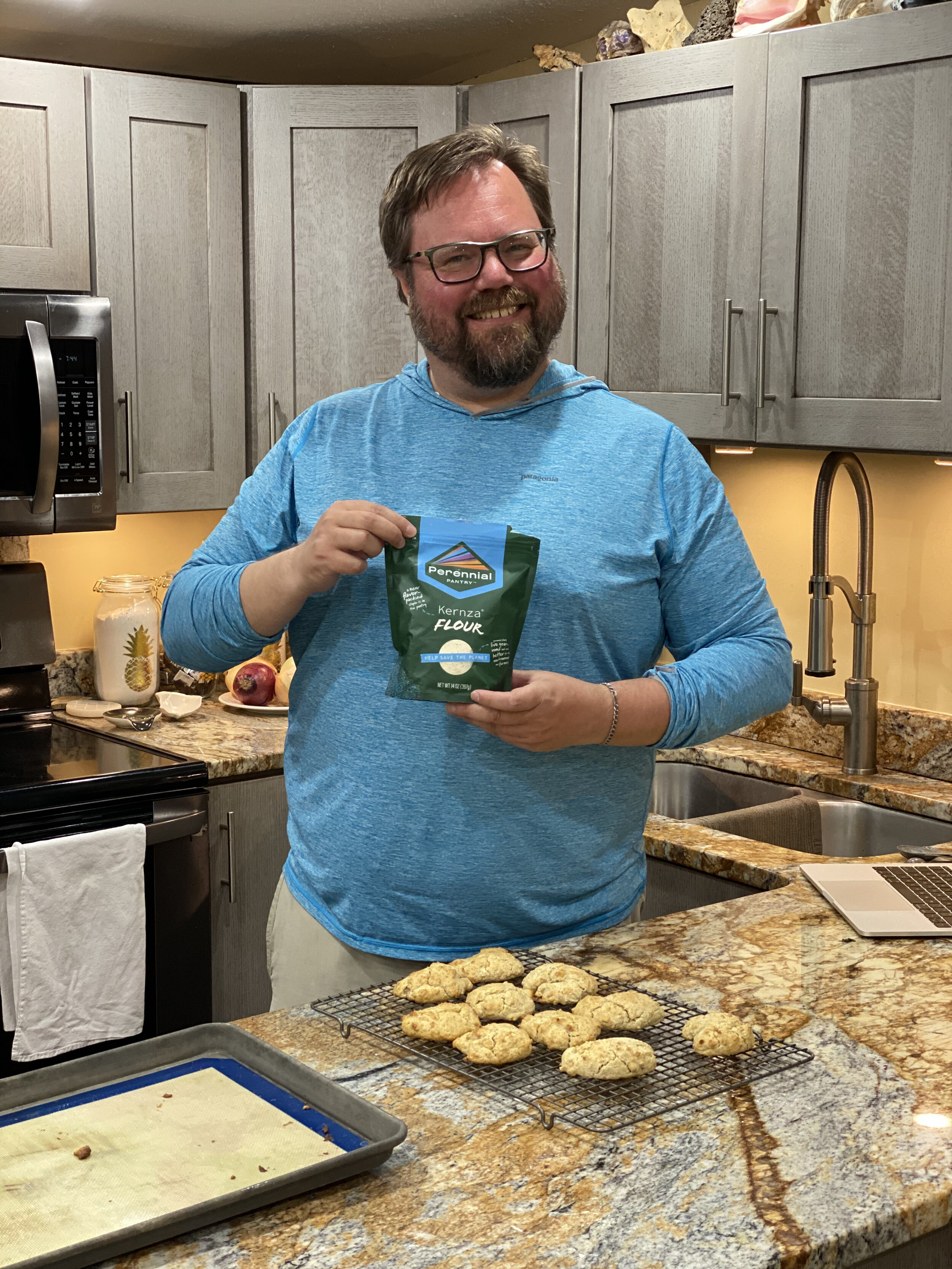Over the last two decades, this part of the river has shifted toward clearer, plant-filled waters, which helped yellow perch thrive alongside the long-established bluegill population. But as both species expanded in these shallow, vegetated areas, scientists began to wonder: were they competing for food—or even eating one another?
Read MoreLake Pepin: A River Resource in Transition
Lake Pepin is filling in with sediment ten times faster than before settlement, shrinking habitat and threatening recreation. Most of that sediment comes from the Minnesota River, where higher flows and eroding bluffs, ravines, and streambanks are sending more material downstream than ever before.
And yet, the news isn’t all grim. Recent monitoring shows clearer water and a resurgence of rooted aquatic plants in backwaters near Lake Pepin. These plants act like natural filters, trapping sediment and providing food and shelter for fish and wildlife.
The big question: can these promising trends last without stronger efforts to reduce erosion upstream?
👉 [Read the full report by Norman Senjem here]
PFAS, Permits, and the Path to Lake Pepin
Just outside the Twin Cities, in a corner of Cottage Grove, a small creek winds its way through an industrial corridor. Most Minnesotans have never heard of it. It has no name on the map. But for anyone who cares about the health of the Mississippi River—and Lake Pepin in particular—it matters more than you might expect.
That creek is the discharge point for treated wastewater from the 3M Cottage Grove facility, a sprawling industrial site that has produced chemicals, adhesives, films, and more for decades. Under the latest water pollution permit issued by the Minnesota Pollution Control Agency (MPCA), the facility is facing new requirements that reflect growing concern over what ends up in the water flowing downstream.
Until recently, regulators treated the creek as little more than a pipe—assuming that anything discharged there mixed immediately and harmlessly with the Mississippi River. But the new permit takes a different approach: it classifies the creek as a real surface water body, with its own water quality standards. That’s more than a technical shift. It means 3M’s discharge must now meet stricter pollutant limits to protect not just the Mississippi River, but the unnamed creek itself and all waters downstream, including Pool 2 and Lake Pepin
In past permits, the creek was recognized as a surface water—but the focus was often on its proximity to the Mississippi River, with the assumption that discharges diluted quickly. The new permit strengthens protections for the creek itself. It applies clear water quality standards, sets effluent limits with the creek’s conditions in mind, and requires more rigorous monitoring. That’s more than a technical shift. It means 3M’s discharge must now meet stricter pollutant limits to protect not just the Mississippi River, but the unnamed creek and all waters downstream.
Among the most important changes are new limits and monitoring requirements for PFAS (per- and polyfluoroalkyl substances)—a class of persistent, toxic chemicals widely used in manufacturing, including at 3M. These "forever chemicals" have been found in groundwater, surface water, and even fish tissue in the region. The permit requires 3M to monitor and reduce PFAS discharges, and to implement advanced water treatment systems, including granular activated carbon (GAC), reverse osmosis (RO), and anion exchange (AIX) systems to capture and remove these contaminants before they reach the river
Importantly, the facility must now comply with a new phosphorus discharge cap of 6,253 kilograms per year—a limit derived directly from the Lake Pepin and Mississippi River Eutrophication Total Maximum Daily Load (TMDL) plan. This cap aims to reduce nutrient pollution that fuels algal blooms and degrades aquatic habitat in our lake
Even suspended solids—the tiny soil particles that cloud water and contribute to sediment buildup—are addressed in the new permit. As 3M increases how much water it discharges, the total amount of solids it’s allowed to release also increases. But here's the key: the concentration of solids in the water must still stay below 30 milligrams per liter, which is under the state’s water quality standard.
This story is technical, but the implications are clear: the way we manage upstream facilities has a direct impact on water quality in Lake Pepin. Strong permits like this one don’t just reduce pollution in Cottage Grove. They ripple outward—to Hastings, Red Wing, Bay City, Stockholm, and to everyone who depends on a cleaner river and lake.
At LPLA, we’ll keep tracking the decisions made in boardrooms, treatment buildings, and government agencies far upstream. Because what happens to that small, unnamed creek in Cottage Grove doesn’t stay there—it flows to Lake Pepin.
Flooding on the Mississippi River
There’s been no shortage of footage on this year’s flooding of the Upper Mississippi River in Minnesota and Wisconsin. For those concerned about the ongoing sedimentation of Lake Pepin, this flood brings more bad news. MPR News reported on the partial failure of the Rapidan Dam, which had an estimated 11.6 million cubic yards of sediment behind it. “More than a century’s worth of sediment was unleashed downstream into the Blue Earth River after the partial failure of the Rapidan Dam last week.” Rapidan Dam partial failure sent more than a century’s worth of sediment pollution downstream | MPR News
The Blue Earth Dam outlets directly into the Minnesota River, which sends close to 1 million metric tons of sediment to Lake Pepin every year. The Blue Earth and Le Sueur Rivers collectively can account for up to 50% of the Minnesota River’s annual sediment load.
Meanwhile, workers at the top of the Lake Byllesby Dam, west of Cannon Falls, are close to completing a $48 million renovation to replace the hydroelectric turbines originally installed in 1910, reported the Pioneer Press. “Last month, heavy rainfalls drenched Minnesota, causing significant water flows throughout the state, notably along the Blue Earth River near Mankato. The Rapidan Dam was overwhelmed by the rushing water, as 34,800 cubic feet per second blasted down the river…Both dams have a similar hollow concrete construction and are of the same age, but the geography between the two sites varies greatly and the Rapidan Dam experienced water flow rates at a much higher clip. To put the historic water flow figures from the Blue Earth River in perspective, the Cannon River at the Lake Byllesby Dam crested at about 15,000 CFS on June 22, less than half of what Rapidan experienced.” Dakota County dam upgrade expected to double hydro power output (twincities.com)
Both the Cannon River and the Minnesota River need to cut their sediment loads in half by 2030 to meet Minnesota’s water quality standards for the impaired portion of the South-Metro Mississippi River to Lake Pepin.
The Waterways Journal reported on the closure of Lower St. Anthony Falls Lock and Dam to all traffic on June 17 and Minneapolis area locks and dams to recreational vessels on June 21st from the resulting high water in Minnesota.
The pressure put on our waterways by peak flow events like we just experienced create the most destructive impacts to our waterways, our ecosystems, and our infrastructure. We need everyone on board to keep the river healthy and viable for all. Increasing opportunities for groundwater recharge, wetland restoration, water storage for irrigation, water and sediment control basins, and continuous living cover (perennial and winter-annual crops) in vulnerable areas can help!
Driftless Trout Streams Feed Lake Pepin
“There’s an enchanting geological masterpiece located in the Midwest called the Driftless Area. This unique region, unscathed by ancient glaciers, is characterized by aggressive topography-steep, breathtaking valleys, jagged limestone cliffs, and massive stands of mixed timber. The real treasure of the area lies beneath the ground: Some 600 natural springs feed thousands of miles of clean, frigid streams across the Driftless. It’s an ideal landscape for supporting trout.” Fishing the Driftless Area: The Best Kept Secret in the Trout World (outdoorlife.com)
Situated in the Driftless valley of the Mississippi River is Lake Pepin, whose water receives the discharge from 10 Class I and II trout streams. The Rush River is Lake Pepin’s longest tributary, flowing nearly 50 miles from its source near Baldwin, Wisconsin, to its mouth at Maiden Rock. It’s nearly 185,000 acre watershed includes parts of St. Croix, Pierce, and Pepin counties. Wells Creek, the largest on the Minnesota side, drains around 46,000 acres.
“Substantial upstream groundwater input helps maintain the perennial cold, clear water conditions that make the Rush one of Wisconsin’s finest trout streams, well known among anglers regionwide. Degraded water conditions likely decimated Rush’s native brook trout population during the early- to mid-20th century. But soil conservation practices and restoration efforts have since helped shift the trajectory, and an introduced brown trout community is now thriving in Rush.” - Emily Green (Rush River: a renowned trout fishery prone to flooding and erosion - Lake Pepin Legacy Alliance)
The Rush River Macroinvertebrate Monitoring Project, a newly based volunteer effort, took a closer look at the health of the Rush River by sampling macroinvertebrates across 16 locations within the watershed. Stoneflies are one of the most sensitive species to the presence of pollution and were found in 10 of the 16 sampling sites.
Stonefly: photo courtesy of Carl Nelson
"Although it remains a high-quality fishery, the Rush River is not immune from the many stressors facing our trout streams. These streams and the surrounding landscape are sensitive ecosystems that depend upon a complex food web, with macroinvertebrates being a critical element for energy transfer from organic matter to higher tropic levels." - Carl Nelson, Project Coordinator
The project team noted the importance of several environmental factors like organic pollution and widening stream channels on macroinvertebrate-based metrics. Areas with severe erosion are contributing to sedimentation within the stream, changing the historic cobble-bottom and reducing habitat for invertebrates and fish. In Minnesota, Wells Creek faces similar challenges.
Understanding the threats posed to these sensitive ecosystems allows us to advocate for thoughtful land use that maintains the integrity of our healthy Driftless trout streams and Lake Pepin’s own fisheries.
Join our efforts to protect this incredible resource: Support — Lake Pepin Legacy Alliance
What's in Lake Pepin's water?
How much do you know about the plants that grow in the Mississippi River? Not just the ones along the shoreline, but underneath the surface of the water, too! The presence or absence of some aquatic vegetation in the river, lake, and backwaters indicates an ecological shift occurring in the system. If we see more native vegetation, like narrow leaf pondweed and wild celery, it is because the water is clear enough for it to grow.
Vegetation is measured in Lake Pepin and the surrounding backwaters annually by staff at the Lake City Department of Natural Resources. In 2006 and 2007, less than 1% of Lake Pepin’s surface acres contained submerged, floating leaf, or emergent aquatic vegetation. Fortunately, biologists have been documenting increasing trends of vegetation in this stretch of the river and have identified the presence of 58 different aquatic plant species!
Submersed aquatic vegetation in the Mississippi River is subjected to variable light conditions throughout any growing season or series of growing seasons. Monitoring data shows that submersed aquatic vegetation can withstand limited durations of high turbidity, but that prolonged turbid conditions, especially over two or more consecutive years, can impair growth and survival.
The Minnesota Pollution Control Agency has developed a standard for total suspended solids at the head of Lake Pepin that - if achieved in 6 out of 10 years - would allow more consistent growth of submersed aquatic vegetation.
Recent monitoring data suggest that we may be meeting or close to meeting this target and Lake Pepin Legacy Alliance is gathering information to better understand what this means for the overall health of the lake. There is no Minnesota water quality standard for the rate of in-filling of Lake Pepin from sedimentation.
Invasive Carp in the Mississippi River
Earlier this month we shared the Minnesota Department of Natural Resources (DNR) press release on the largest single capture of invasive carp in Minnesota & Wisconsin’s waters. In January and February of 2024, Lake Pepin Legacy Alliance (LPLA) and Friends of the Mississippi River will be co-leading a series of community meetings in St. Paul, Red Wing, and Winona, MN (virtual option available, too) to provide more information on this issue. Registration is now open.
In 2014, the Minnesota DNR updated their Invasive Carp Action Plan, which was designed to assess the threat posed by bighead, grass, and silver carp, and identify actions to minimize their impact in Minnesota. They cautioned that the technology was not available to accurately determine the abundance of invasive carp in the Mississippi River and no technology existed that would offer a 100% deterrence to the upstream migration of carp. They did identify evidence suggesting modified operating procedures at Lock and Dams #2 (Hastings), #5 (Minnesota City), and #8 (Genoa, WI) may hold hope for halting or slowing their spread up the Mississippi, Minnesota, and St. Croix Rivers.
Nine years later, on November 30, 2023, the Minnesota DNR confirmed capture of 323 invasive carp near Trempealeau, Wisconsin. This is the largest single capture of invasive carp that has occurred in Minnesota to date. The largest previous catch in the same location was 51. The larger numbers are due, in part, to improved fishing technology and not necessarily because the carp weren’t already there.
In LPLA’s 2023 Annual Report we shared responses to our own interview with Minnesota lead carp physiology and behavior researcher. Here’s what we learned:
Q: What is the status of carp in the Mississippi River?
A: They have moved beyond Lock and Dam 8, which was entirely predictable. Carp have a natural drive to swim upstream to reproduce. They can swim through the spillway gates when the water levels are high. The more likely reason carp are not reproducing in Minnesota yet is because the spillway gates are lower, and the locks and dams are more challenging to get through. At Lock and Dam 5, the spillway gates are only out of the water 2% of the time. Lock and Dam 4 is also a strong place to stop them from moving upstream. We can stop 99% of carp at almost no cost, just by regulating the spillway gates and putting a deterrent in the water.
We can reduce the number of carp moving upstream further if Lock and Dam 4 and 5 work in tandem to protect Lake Pepin by regulating the spillway gates – even just adjusting them 2 inches. Then you can add a bioacoustics fence to deter even more from coming through. Ultimately, the fewer that get through, the less likely the chances are of reproducing in Lake Pepin. That chance Is never zero because some will inevitably come through and you just need the right number and for the male and female to find each other for the population to explode.
Q: How long do we have before invasive carp could start reproducing in Lake Pepin?
A: There is still a lot we do not know. Carp can swim fast, so they could swim from LaCrosse to Lake City in two days. Will they? We do not know. Evidence shows that carp like to reproduce when they have larger numbers – a strategy known as predator swamping. In Canada, they believe that 10 carp constitute a large enough population to reproduce. We do not know that number, but we do see that larger numbers tend to trigger reproduction. A year of big floods could allow them to take off.
The Minnesota DNR has updated their 10-year Invasive Carp Action Plan to reflect the past nine years of research and learnings. This new plan has not yet been released to the public, but will be available this winter. The Invasive Carp Community Action Meetings co-hosted by Lake Pepin Legacy Alliance and Friends of the Mississippi River will provide attendees with an opportunity to learn about the new plan, ask questions, and share feedback.
Registration is open for these meetings. Light snacks and beverages will be provided for those who attend in person.
January 24, 2024 - Red Wing, Minnesota | 5:00 - 7:00 PM
January 30, 2024 - St. Paul, Minnesota (virtual option available) | 5:00 - 7:00 PM
February 1, 2024 - Winona, Minnesota | 5:00 - 7:00 PM
Working River: Islands Growing & Islands Washing Away
In 1973, the State of Wisconsin initiated a lawsuit against the Corps of Engineers related to the effects of their operation and maintenance program on the Upper Mississippi River and revealed that sediment from uplands and stream banks, as well as current methods of channel maintenance (especially dredging and placement of dredged material), were damaging the fragile backwaters, marshes, and sloughs for which the river is famous.
The lawsuit and subsequent river planning revealed that little information was available on many other components of the river, and the lack of information would make it almost impossible for government agencies or Congress to evaluate alternative means to manage the river in a more balanced way without considerable additional study. Since that time, numerous partnerships have been formed to gather more information about the river, beginning with what those in the industry call “The Great One.”
The Great I: A Study of the Upper Mississippi River just passed its 43rd birthday in September and is significant in its depth and range of river planning. It set the stage for ongoing interagency collaboration and long-term data collection and stressed the urgency in our decision making.
“Although previous actions have enhanced fish and wildlife habitat, we are realizing we may be on the threshold of irreversible deterioration. The greatest need appears to be for intelligent and rational management of this recourse that is so important to our lives.” (Great I: A Study of the Upper Mississippi River, Volume One, Chapter II, II-1, September 1980)
Perhaps The Great One could have predicted that in just four years, a ¼ mile island would emerge at the head of Lake Pepin where it had been accumulating beneath the water all along. Much of what builds up at the head of the lake ( ~ 80% ) comes from erosion in the Minnesota River watershed, the second largest tributary to the Upper Mississippi River. Some of the material settling at the head of the lake comes from a much closer source just upstream, where other islands are washing away.
In 1994, the Long-Term Resource Monitoring Program (established in response to the Great I), produced a special report on recreational boating impacts on the Upper Mississippi River System in Pool 4, near Red Wing, Minnesota.*
Beginning in 1992, a series of field investigations examined potential physical and water quality changes associated with recreational boating on the Upper Mississippi River. Investigations were designed to measure and compare erosion rates along bank shorelines and document water quality changes associated with boating activities between river miles 790.7 and 787.5 on the main channel and river miles 792.5 to 786.5 on the Wisconsin channel.
The report found that boat waves, alone or in combination with other contributing factors (like water levels, boat traffic density, presence of shoreline stabilization features, etc.), may be responsible for river shoreline erosion. The report was not able to quantify the amount of erosion that could be attributed to one specific variable. The study strongly suggested that the passage of many large, deep draft boats are the major contributing influences for shoreline erosion prevalent along the Main Channel.
Nearly 30 years has passed since the study was published, and members of the Red Wing Wildlife League are frustrated that no clear process exists to protect their land from washing into the river. The island their members use for seasonal hunting and recreation is 75 feet narrower than it was 50 years ago.
The League has tried a few innovative techniques to break up the wave impact, which have been successful on small streams. Along the main channel of the Mississippi River, however, they are ineffective. In 2003, the Minnesota Department of Natural Resources looked more closely at shoreline and water quality impacts from recreational boating on the Mississippi River.
In that study they surmised that shorelines along the main channel of the Mississippi River, when exposed to significant recreational boat traffic, erode at an average rate of 2-3 feet per year. An estimate of sediment released to the river from Lock and Dam 3 to the head of Lake Pepin indicates that streambank erosion contributes 82,600 cubic yards of sediment annually.**
The Minnesota Department of Natural Resources stated a clear need for additional water surface use management of the Upper Mississippi River to maintain a careful balance of the complex river environment. Among those include “its value as a wildlife sanctuary and rich mosaic of ecological communities; an important fishery resource; a corridor for commercial commerce; and as a provider of an extensive variety of recreational opportunities… certain aspects of current water surface use practices are in direct conflict and must be addressed through a collaborative and adaptive management process.”
In places along the river where management practices have been established to provide stability and mimic natural processes, you can see the habitat and wildlife return.
*Johnson, S. 1994. Recreational boating impact investigations - Upper Mississippi River System, Pool 4, Red Wing, Minnesota. Report by the Minnesota Department of Natural Resources, Lake City, Minnesota, for the National Biological Survey, Environmental Management Technical Center, Onalaska, Wisconsin, February 1994. EMTC 94-S004. 48 pp. + appendixes (2 pp.)
**Shoreline and Water Quality impacts from Recreational Boating on the Mississippi River, Minnesota Department of Natural Resources, Mississippi River Landscape Team, 2003
Working River: A New LPLA Blog Series
[River Mile 784.5 on the Mississippi River in 2021]
Going from 17 feet of depth in the channel to just 2 or 3 feet, “the depth finder on Zach Paider’s 23-foot tow boat on the Mississippi River tells the story of the struggle to keep sediment from choking Lake Pepin.” This was the first sentence of a 2018 Star Tribune article on the sediment buildup in Lake Pepin, and the year Lake Pepin Legacy Alliance heard loud and clear from the boating community that the channel at the head of the lake was no longer safe for navigation.
In 2020, we drafted a letter to Representative Angie Craig (whose district, at the time, included the river) to request help around this growing issue for commercial and recreational boaters. In partnership with groups like River Valley Marina, whose towboat calls for boat groundings were up 300% over historical, we urged Craig’s office to press the Corps to prioritize maintenance of the designated width and depths in the channel at the head of Lake Pepin.
Near Presbyterian Point, the channel’s authorized width (authorized by congress for the Corps of Engineers to maintain) is more than 100 feet wider than the channel sits today. The Corps primary reason for not dredging this area is the lack of placement sites for the silty material. Meanwhile, commercial and recreational traffic crawls through the narrow passage with predictable groundings and damage to vessels.
Every week, LPLA posts the Channel Conditions report from the Corps of Engineers on our website to help boaters access information about the river. The green border indicates “conditions are good - routine dredging may occur.” The yellow border says “use caution when navigating through the area,” and the red border says “use extreme caution when in this area.” And every week, for as long as we have been looking at these channel condition reports, river mile 784.5 - 785.5 (the head of Lake Pepin) is red.
In the above sample from October 18, 2023, the description for the head of Lake Pepin reads “200’ between 9’ contours at flat pool on a 500’ recommended bend.” This translates to “the channel is 200 feet wide in the area the Corps is authorized to dredge, but they would recommend the channel be 500 feet wide.”
Last year the Corps authorized $500,000 to study channel management alternatives that could improve conditions for the stretch of the river shown in the map below (Colvill Park to Greene Point). That report is not yet complete and it does not include considerations for reducing sediment sources.
In our 2020 letter to Rep. Craig, we noted that our coalition can bring together a broad sector of river users to explore continued beneficial use opportunities that alleviate dredging needs, improve commercial and recreational traffic, and support ongoing habitat restoration which would build off the existing project in Bay City and planned project in Wacouta Bay. This could offer a longer-term solution to a narrowing channel, but would require multi-state, multi-agency collaboration.
If we can focus on a concerted effort to address the problem where it is rather than send it further downstream, we have a real opportunity to create multiple benefits for a multi-use river.
[An Economic Impact of Minnesota’s Inland Waterways, National Waterways Foundation]
Red Wing, Minnesota, is one of only five river ports in Minnesota and located just upstream from the choke point. In 2015, nearly 97,000 tons of commodities moved through Red Wing’s port, according to the Red Wing Port Authority’s website. The port is also a refueling point for the majestic steamboats that bring visitors to the area.
[The 166-passenger river vessel: American Duchess]
The Driftless: A Living Museum Worth Saving
The Driftless Area, so named because of the absence of glacial deposits – or “drift” – is a unique geographical region that encompasses most of southwestern Wisconsin, part of southeastern Minnesota, bits of northeastern Iowa, and a portion of northwest Illinois.
Unlike most of the Midwest, which was repeatedly ground smooth by glacial ice, the Driftless Area is filled with tall bluffs, forested ridges, narrow ravines, and deeply carved river valleys. The Mississippi River cuts through the heart of the region, forming Lake Pepin at its widest point.
Not only is the geology surrounding Lake Pepin and the Upper Mississippi River Valley unique, but the ecosystem is a “biodiversity hotspot” and home to rare habitats like goat prairies and oak savannas. Unfortunately, the Driftless Region is facing a hastened loss of biodiversity, mainly caused by poor land management. This stems anywhere from unsustainable farming practices to the insurgence of invasive species. In order to preserve the natural richness of the Driftless Area, measures need to be taken to promote collaboration in conservation efforts. There are many organizations working to make an impact, and by focusing on biodiversity hotspot and a feature synonymous with the Driftless Area, the Lake Pepin Legacy Alliance is working to restore and protect what's threatened before it's too late.
Drainage Matters
Earlier this spring, our soils were 'in the trenches' as they faced one of their most critical moments of the year, determining the health of our waters. Bare fields (sometimes with applied manure) still waiting for seeds to sprout are vulnerable to heavy rain events.
The pounding of water droplets on the soil can strip sediment and wick manure and pesticides directly into fisheries and drinking water sources.
Since as early as the 1930s, the federal government has incentivized farmers (via the Farm Bill) to drain their fields during spring rains. This allows famers to plant as early as possible and maximize production. And actually, more drainage can mean less surface runoff on the field. Drainage projects, like tiling or burying permeable pipes in fields, change the dynamics of the water table. With this infrastructure, water is accelerated through the soils into our ditches, tributaries, and mainstem river systems, with a comfy (but unwanted) place for the upstream pollution to settle:
The Widening of the Mississippi River at Lake Pepin
Where the Flow Slows Down
And Particulate Matter
Can Finally Rest
On Growing Silty Islands
In Minnesota, we have lost roughly 10 million acres of wetlands, and much of this land is now being farmed in the dominant corn/bean system, adding sources of nutrients to the Lake Pepin watershed. Ironically, wetlands are the best filters for nitrogen, phosphorus, and sediments that exist in our toolbox of natural protections.
Wetlands are shallow, biologically active native ecosystems that are also highly stable storage of climate-warming gasses. Dead organic material stays preserved in their basic chemistry acting like giant climate cooling batteries, holding and preserving atmospheric chemistry as long as they stay undisturbed. In this state they can provide home to the most diverse ecosystems in the world - migratory stopovers and nesting, insect nurseries, and super nutrient-dense food and forage for every kingdom.
Wetlands' soft, slow, and old ways buffer the land and shores from highs and lows, storms and floods, sediments, and Agri-toxins.
Each spring a new docket of drainage system proposals are considered by counties and state departments overseeing agricultural land use. For example, a landowner can apply for a modification to increase the pipe size in their drainage system to prevent water-logged fields. These projects avoid certain restrictions by re-classifying waterways under a less protected status.
Three “improvement” projects are being proposed on tributaries to the Minnesota River (the largest contributor of sediment, nitrogen, and phosphorus to Lake Pepin) and within the most erosive corridor of that watershed.
Blue Earth County JD 33,
Faribault County Ditch 26 Lateral 1
Watonwan County Ditch11
Local groups in the Minnesota River watershed are more actively watching these drainage improvement project proposals because of their cumulative impact downstream. Meanwhile, farmers can use predictive tools (provided by state agencies) to optimize and protect their neighbor’s water by planning their fieldwork around and between large rainstorms.
Constructed wetlands are a cost-efficient, long-term, highly effective tool to reduce nutrients exiting fields that could otherwise affect local waterways. They work with tiled lands as a buffer to watersheds. A relatively small wetland, around 6% of the tile-drained agricultrual area, can reduce nitrogen by nearly 50%. If applied at scale, this approach could help address excess nutrients from farms throughout the Midwest. These types of wetlands are one of many "edge of field" and in-field practices and a mechanism farmers can deploy to support conservation.
How we treat the land is how we treat out water - the systems are one.
Floodplain Forests on the Upper Mississippi River
Written by Andy Meier, U.S. Army Corps of Engineers
Two hundred years ago this year, Giacommo Beltrami, an Italian adventurer, rode the steamboat Virginia from St. Louis to Fort St. Anthony, now Fort Snelling in the Twin Cities, on a quest to find the source of the Mississippi River. The Virginia was the first steamboat to successfully navigate the Mississippi River to Fort St. Anthony, and Beltrami noted as he traveled how the river looked at that time: "Little islands, studded with clumps of trees, among which the steamboat was winding its course, appeared like most enchanting gardens.” In many places on the Upper Mississippi River today, you can still find these places, paddling through backwaters on a kayak or running up back sloughs with a fishing boat, the tree covered islands remain enchanting. A lot has also changed since Beltrami made that voyage in 1823. Most people who use the river today are accustomed to seeing large areas of open water, consistent river depths throughout the summer, and expansive floodplain marshes. When the Virginia entered the south end of Lake Pepin with Beltrami onboard in 1823, which he said was like entering “the amphiteatres of antiquity,” it would have been the first time for hundreds of miles in which he saw open water. The Upper Mississippi River of 1823 was made up primarily of isolated backwater lakes with scattered marshes and extensive floodplain forests. Water levels naturally dropped during the summer months meaning that even many areas on the main river channel were shallow enough to wade across. Shifting sandbars made navigation difficult.
The first changes came with settlement of the river valley and floodplain by Europeans in the mid- to late-1800s. Settlers were hungry for land to farm, and many areas in the floodplain were cleared for agriculture, even if only for the production of marsh hay and cattle pasture. Until the 1860s, steamboat traffic on the Upper Mississippi was primarily fueled by wood, so further cutting of forest almost certainly occurred to fuel those steamboats, which would stop periodically along the river to “wood up” at locations where an enterprising local had piled cordwood to sell to the steamboats. Higher elevation areas were cleared for homes and cities. Many of today’s Upper Mississippi river towns occur in places that were once forests or prairies.
From time immemorial the Upper Mississippi has been used for transportation, with Native people active within the floodplain as far back as 12,000 years ago. But the need for a reliable channel for navigation brought about the next big change in the river in the 1930s with the building of the Locks and Dams as part of the 9-Foot Channel Project. The 9-Foot Channel Project was authorized by Congress to ensure reliable transportation of goods on the Upper Mississippi between St. Louis and St. Paul, and relied on the establishment of Locks and Dams to elevate water levels between each dam enough that a 9-foot depth could be maintained in the main river channel. The dams and upstream pools were designed to provide those minimum water levels throughout the year, enabling river navigation at any time that the river was ice free. The 9-foot Channel continues to function today and more than 90 million tons of commerce is moved within the project every year.
However, installation of the Locks and Dams also brought about ecological changes in the Upper Mississippi. What had once been a free flowing river, subject to high and low water periods based on precipitation trends within the larger watershed, is now a river constrained in a series of stabilized pools, with minimum water levels in these pools maintained throughout the year. (It’s worth noting that the pools were not designed to hold back high water, so in periods of high water, the river is able to return to a largely free flowing state as water flows over the dams.) The impacts of this permanent inundation on river habitats were evident within a few years of completion of the dams. Within four or five years, large areas of forest that had been flooded had converted to open marsh habitats, and many areas of historic marsh had converted to open water conditions. Conservationists at the time, though, actually appear to have largely viewed this expansion of marsh and open water habitat as a good thing because it allowed for an expansion of habitat available for fish and waterfowl. At that time, forest habitat appears to have been considered as less valuable for wildlife than marsh and aquatic vegetation.
It's easy to think that changes in forests were locked in place with the building of the dams, but we are currently in a third phase of forest change on the Upper Mississippi, one driven much more by changes in precipitation patterns and land use in the watershed. Over the last few decades, the watershed that supplies water into the Mississippi River has experienced an increasing trend in annual precipitation, and part of that change in precipitation is associated with a substantial increase in the number of very large rain events. The larger watershed outside of the river floodplain that Beltrami moved through in 1823 was dominated by prairies and woodlands, with large areas of wetlands scattered throughout. All of these habitats have the ability to capture water in the soil, slowing the flow of water into rivers. With agricultural and urban development, however, areas that were once able to absorb rain and reduce runoff into tributary rivers have become less and less permeable, with rainwater in many areas running off rapidly into streams and rivers. As a result of both of these factors, the Upper Mississippi River has seen a trend of generally increasing river flows (with some drier years mixed in) over the last few decades. What this has meant for remaining forests in the Upper Mississippi has been a continued but slow loss of forest at the edges of areas that have become increasingly wet and are now no longer dry enough to support the growth of trees. If the upward trend in river flows continues, it’s likely that forest loss will continue to occur over the next decades as areas become less suitable for forest.
But even with all these changes, the Mississippi River floodplain forests that remain are amazing places. Floodplain soils are high in nutrients and moisture, key ingredients for trees to grow fast and large. Many of the trees that grow in the floodplain have timed the dissemination of their seed for early summer, a time that conveniently corresponds with the time of the year when spring floods have usually dissipated and aggressive competition from grasses and other weeds is suppressed by newly deposited sediment. Many floodplain tree species produce tiny seeds, thousands upon thousands of them, that get caught in the wind and carried in every direction. Cottonwoods are some of the fastest growing trees on the river, but they start out as a tiny seed with a parachute of fluff attached to help them float through the air. The vast majority of the seeds just float away and land somewhere that’s not suitable for trees to grow, but when those tiny seeds land on moist, fresh sediment, they germinate, put down roots and grow. And they grow FAST! Young cottonwoods can grow to over five feet tall in just two years, and by the time they reach their hundredth birthday, they can tower over that forest at ninety feet or more. Outside of some old growth forests in wilderness areas in the Upper Midwest, the floodplains of the Upper Mississippi boast some of highest concentrations of big trees in the region. While trees 40 inches in diameter (that’s just over 10 feet around the trunk) are rare in most midwestern forests, it’s rare on the river to walk a day in the woods and not run into a dozen or so of them, and sometimes many more. And if you could dig down around the bottom of a big old silver maple tree, you might find the base of the tree four or five feet down, buried under a century’s accumulation of sediment.
The forests in Pool 4 are reflective of forests throughout the northernmost stretch of the navigable portion of the Mississippi River. Like in most other pools, large areas of forest have been lost since the 1800s, with much of the area converted to marsh or aquatic habitat, though large areas of contiguous forest still remain. The Nelson-Trevino Bottoms and the Tiffany Bottoms complex comprises one of the largest contiguous patches of floodplain forest in the upper river and, given the difficulty of accessing the interior of these areas, there are many places that have likely seen very little human activity over the last century. These large areas of contiguous forest are critical habitat for dozens of wildlife species. The prothonotary warbler is a little bright yellow bird that lives almost exclusively in wet forests dominated by silver maple. If there’s not water around, you won’t find a prothonotary warbler. And these little birds are completely dependent on floodplain trees for their survival – they are the only species of warbler in the eastern United States that use tree cavities for nesting. Without trees in the floodplain, birds like the prothonotary warbler would disappear from the landscape.
Floodplain trees are tough, and there are places in Pool 4 where forests are healthy and thriving. But overall, the long-term prognosis for the remaining acres of floodplain forest is not good. In most areas, there are no young trees growing under the existing forest to replace the older ones when they die. Variable and unpredictable flooding over the last few decades has meant that areas of forest that were historically stable are now becoming much more vulnerable. And the impact of exotic insects, like the emerald ash borer, or diseases, like Dutch elm disease, will continue to be felt for centuries – elm and ash are the two most common species that are found growing as young seedlings under existing forest canopies and the loss of those tree species as canopy trees further accelerates the transition of current forests to marsh or other habitats.
With all that in mind, management and rehabilitation of forests in Pool 4 and throughout the Upper Mississippi River is critical. Management of large river habitats often focuses on aquatic areas, but in the Upper Mississippi, the long-term health of floodplain forests have become a top priority for agencies with responsibility for management of this invaluable ecosystem. Some floodplain forest management is being conducted using dedicated annual budget funding for environmental management. As an example, the US Army Corps of Engineers St. Paul District has foresters on staff on the River who are responsible for utilizing budget funding for Environmental Stewardship to conduct forest management on Corps-owned land within the river floodplain, and management on numerous sites in Pool 4 has focused on control of invasive species and establishment of young trees. The US Fish and Wildlife Service has put a significant emphasis on assessment of the conditions of the forests on Refuge lands in Pool 4 and has identified numerous areas in need of rehabilitation. Additional exciting opportunities are also on the horizon. The Upper Mississippi River Restoration Program, a partnership between the Corps, the US Fish and Wildlife Service, and Departments of Natural Resources from Minnesota, Wisconsin, Iowa, Illinois and Missouri, is in the process of developing a series of large projects in the lower end of Pool 4 that will incorporate improvement in both aquatic and forest habitat, including creation of higher elevation areas to establish young forest on and management of hundreds of acres of currently forested areas that could benefit from tree planting and other management actions. Other major funding sources leveraging federal and state partnership along with the key advocacy of the Lake Pepin Legacy Alliance, have enabled the development of another large project near Bay City, Wisconsin in Upper Pool 4 which also includes creation and enhancement of forest habitat alongside aquatic habitat improvements.
Two centuries have passed since Giacomo Beltrami boarded the first steamboat to travel to St. Anthony Falls, and it’s unlikely that he’d recognize it as the same river. Settlement and development of the river floodplain, channel improvements for navigation, and increasing variability in climate have all brought about drastic changes to the river and shifts in the habitats that the river supports. The extensive floodplain forests he saw still remain, but the patches are smaller and the health of them is poorer. We can only wonder what these forests will look like two centuries from now, but the opportunities today to actively manage and improve those habitats to ensure that there will still be forests on the floodplain in 2223 are opportunities that we can’t pass up.
Nitrates in Driftless Area Groundwater | How can we protect our water?
Many folks in the Lake Pepin area have enjoyed a sunset meal at Ted Fischer and Robbie Bannen’s farm. Their A-to-Z Produce & Bakery in Maiden Rock, Wisconsin, hosts a bi-monthly wood-fired pizza night that has attracted thousands of folks over the years to try their handmade pizzas crafted from ingredients grown and raised on-site. They even mill their own wheat! As a no-spray, regenerative farm for decades, Ted and Robbie test their well water annually.
Ted reports that the nitrate levels in their water have rarely ever been below 10 ppm - the EPA-recommended safe level.
"Water testing just needs to be easy and free for everyone. Right now, the states count on neighbors to report each other applying nitrogen at the wrong time, that's not realistic. There has to be enforcement at the local level."
Even the need to test their water illustrates a painful and growingly more common irony for many producers who, despite their best farming efforts, are forced to buy, filter, or even shoulder the expense of drilling new wells to drink clean water.
NITROGEN VS. NITRATES
Nitrogen is a naturally occurring element critical to human and plant life, it is a core component of the fertilizers and manure spread in mass quantities on farms in the Midwest. When the nitrogen mixes with oxygenated water, it forms nitrate. Drinking water with high levels of nitrate can cause methemoglobinemia, or “blue baby syndrome,” a potentially life-threatening condition affecting the blood’s ability to carry oxygen throughout the body. Nitrates also have been linked to thyroid disease and certain cancers. Nitrate pollution is largely caused by agricultural runoff. Rainwater picks up the nitrogen in fertilizer and manure and carries it to bodies of water. When nitrate reaches the underground drinking water supply, it’s the good owners’ responsibility to treat their water — with limited, often expensive options — or find another water source.
In Minnesota, nitrate pollution disproportionately impacts low-income communities, according to a 2021 study by the Environmental Working Group. The study found that in Minnesota, 73% of water utilities with elevated nitrate were in areas that fell below the average state income. In Wisconsin, the story is the same. Tia Johnson, Wisconsin NAACP Environmental and Climate Justice chair, reports,
“NAACP’s Wisconsin chapter has reviewed data regarding nitrate drinking water contamination in the state. Nitrate contamination is harming drinking water in several communities with significant numbers of people of color and people living below the poverty line. It is unjust to continue shifting human health and environmental costs of unsustainable farming practices onto vulnerable communities that are least able to protect themselves.”
Well water in Pierce County is particularly vulnerable to impairments due to the porous bedrock that sits between fields and well water sources. Rainwater picks up nitrogen in fertilizer and manure and carries it to nearby bodies of water (i.e., Rush River) or it seeps into the ground. In the 2022 Wisconsin Groundwater Coordinating Council Report to the Legislature (GCCFullReport2022.pdf (wisconsin.gov)), it was estimated that nearly 15% of private wells (689 wells) in Pierce County were over the health standard of 10 ppm. Research has shown increased risk at lower levels and the EPA has found concentrations greater than 3 mg/L indicate contamination from human activity (Report Finds Wisconsin Is Among 10 States Where Nitrate Contamination Is Getting Worse | Wisconsin Public Radio (wpr.org)). In nearby Pepin County, 20% of wells (320) were above the health limit.
While small farmers bear the brunt of fertilizer and input costs increase to maintain pace with their past production, small towns are left to carry the bill for treating citizens’ water. A 2018 study by Schechinger and her EWG colleague Craig Cox found that in small communities, the potential cost of building and operating a nitrate treatment plant ranged from $47 to $378 per person per year. A 2015 report by the Minnesota Environmental Quality Board found that in the most extreme cases, obtaining the needed nitrate treatments would cost thousands of dollars per household.
Preventing nitrate from entering drinking water sources is more effective and less expensive than removing nitrate from the water. Conservation practices that reduce nitrate contamination can include setting aside land that borders a well, planting cover crops on fields in between corn and soy rotations, more widespread adoption of perennial crops, and using a fertilizer that releases nitrogen slowly. Funds from the federal Infrastructure Bill (IRA) are specifically targeted at programs that decrease water pollution up and down the Mississippi and its watersheds. The upcoming Farm Bill offers an exciting opportunity to fund and incentivize more careful stewardship of our water and soils - particularly in sensitive areas.
I reached out to Ted and Robbie's son Emet Fischer and his wife Cella Langer who operate a vegetable dairy and vegetable operation in Hager City, Wisconsin, called Oxheart Farm.
Cella said that right before they signed on their loan they had to submit clean well water results to access their financing.
Cella said it was shocking to realize that their dream farm could be lost due to polluted water from past generations.
How can we expect emerging farmers with the skills and education to steward our local land and water resources to shoulder the burden of past management? For the first time and likely just in time, we can create informed, realistic enforcement and safeguard our nation's precious fresh water. This Farm Bill can take the largest public infrastructure bill in history and create holistic protections.
Blog post written by Alex Keilty, LPLA Program Director
Rush River: a renowned trout fishery prone to flooding and erosion
This article is part of a larger series that investigates what we know about local tributaries around Lake Pepin. Follow us on Facebook and sign-up for our e-newsletter so you don’t miss the next release. If you have information or pictures for other Lake Pepin tributaries, please email us at: info@lakepepinlegacyalliance.org.
By: Emily Green
Lake Pepin’s longest tributary, Rush River flows for nearly 50 miles from its source near Baldwin, WI, to its mouth at Maiden Rock. Its nearly 185,000-acre watershed, including parts of St. Croix, Pierce, and Pepin counties, dwarfs that of any other Pepin tributary. Wells Creek, the largest on the Minnesota side, drains around 46,000 acres. Collecting water from such a large area, and fed by 12 smaller tributaries of its own, Rush swells to a sizeable river by the time it empties into Lake Pepin.
Substantial upstream groundwater input helps maintain the perennially cold, clear water conditions that make Rush one of Wisconsin’s finest trout streams, well known among anglers regionwide. According to Wisconsin Department of Natural Resources (WDNR) fisheries biologist Kasey Yallaly, Rush’s trout density, estimated at around 8,000 fish per mile in some stretches, puts it on par with prized trout streams nationally. “It’s an amazing river. It's got beautiful valleys and hills and coulees and ridges. And there’s just few other rivers that I know of where [trout] populations are that high,” said Yallaly.
The shared storyline of driftless-area streams
Like all the driftless-area streams, the dramatic bluffs, forested valleys, and steep gradient that make Rush so scenic also make it inherently vulnerable to flooding and erosion. In addition, the clearing of watershed lands for agriculture triggered complex changes that impacted the river’s shape and flow; this effect is still playing out today. For example, removing upland forests and perennial grasses increased and hastened precipitation runoff into Rush and its tributaries. Eroded soil then accumulated in Rush’s lower reaches, resulting in areas of steep and exposed dirt banks, which further exacerbate erosion vulnerability. Degraded water conditions also likely decimated Rush’s native brook trout population during the early- to mid-20th century. But soil conservation practices and restoration efforts have since helped shift the trajectory, and an introduced brown trout community is now thriving in Rush.
Stream bank erosion
Upland land management efforts are key to Rush’s health and quality
While soil conservation efforts have been underway since the 1930s, substantial work over the last two to three decades have been key to stemming the tide of soil erosion, and improving Rush’s water and habitat conditions. The Pierce Co. Land Conservation Department (LCD) has been hard at work encouraging landowners to implement conservation practices such as grass waterways and grade stabilization structures. In 2015, they received roughly $4 million in funding from the USDA’s Mississippi River Basin Initiative (MRBI) to fund cost-sharing for landowner conservation efforts focused on reducing sedimentation, phosphorus, and nitrogen loads in Rush’s middle stretch and nearby Isabelle Creek. Rodney Webb, LCD’s Land Conservation Director, said they’ve used the MRBI dollars especially to help landowners implement no-till planting and use of cover crops, two practices that are well documented to reduce erosion, improve the health of nearby waterways, and reduce downstream nutrient loading.
According to Webb, the cost-share program has been very popular among locals. He estimates about $4 million has been distributed to around 100 landowners, and landowners in other stretches of the Rush quickly began asking when their turn for funding will come. “[No-till and cover cropping] have become very popular in these watersheds,” said Webb. “The long-term hope is that the incentives encourage real change. That once the dollars are gone, [landowners] will continue doing them.” The allocation of funds was completed by the end of 2018, but some of the contracts are up to 10 years in length, so the implementation of funded projects continues.
In Webb’s view, there’s no question that funding incentivizes landowners to try new conservation measures. But they’re also increasingly motivated by seeing the damage, and experiencing the costs, associated with big rain events, which are on the rise due to climate change.
“Townships were having to spend a lot of money and time cleaning out road ditches that were filled in with sediment, and people started seeing that that could be prevented by doing things differently. ”
“When you're farming a field, then you drive by one day and see the construction equipment removing soil from that ditch that absolutely came off your field. That's a motivator that maybe we need to do something different,” he added.
Webb is confident that efforts to increase conservation practices have made a difference in the landscape, and for the Rush River. A historic rain event in June 2020 caused near-record water levels and flash flooding on Rush. While the flooding caused hefty damage and erosion, Webb notes that it could have been far worse. “Without all those efforts in place, I'd be scared to see what the river would have looked like,” Webb declared.
Despite gains, ongoing challenges for Rush
There seems little doubt that investments of effort and conservation funding have positively impacted Rush River. Because of its thriving brown trout population, the WDNR has included Rush on its “Healthy Waters” list, created in 2018 based on assessments of fish and macroinvertebrate populations and phosphorus levels in waterways. Yet while the Rush meets WI standards on those metrics, the WDNR does not routinely monitor its rivers and streams for other measures of health, such as sedimentation. Nor does it measure bacteria, which can be associated with nearby animal agriculture production, and if elevated makes a water body unsafe for human recreation. In the absence of monitoring, there’s no way to track how Rush compares to other rivers in those areas.
Despite being categorized by WI as a “healthy water,” some local people have substantial concerns about threats to Rush and its resilience into the future. Retired engineer and Pierce county resident Carl Nelson took it upon himself to study Rush and its ecosystem in depth, and wrote a 2019 report entitled “The Lower Rush River: Present health and a call to action” [2]. In it, he emphasizes that the current threats to Rush are formidable, including ongoing soil erosion that threatens water quality, and lack of riparian and surrounding grassland habitat with an associated loss of biodiversity tied to the river ecosystem. Both Nelson and LCD’s Rodney Webb stress that while upland soil conservation efforts have been highly valuable, the reality is that much more work would have to be done, at tremendous expense, to thoroughly stabilize all of the vulnerable banks and protect Rush from the more frequent and intense rains that are predicted for SW Wisconsin under climate change. Nelson says he would love to see a citizen group form, to share in the protection and advocacy of a healthy Rush River.
Above all, Webb is encouraged that so many local landowners and natural resource agencies are paying attention and eager to adopt and support conservation practices. “I think we're very fortunate. Here in Pierce County, our conservation staff, we have people that are very dedicated and have lots of years of experience. And we have our federal partners, and agency partners and a lot of partners that really help promote conservation. So all together, hopefully we're gaining ground. Hopefully kids down the line can say, ‘Hey, it's not as bad as we thought it was gonna be.’”
[1] See our blog post on Isabelle Creek for more on how the differing water monitoring and categorization approaches between MN and WI result in superficially contrasting pictures of Lake Pepin tributaries across state lines.
Isabelle Creek: one of Wisconsin's 'healthy' streams
One of Lake Pepin’s Wisconsin tributaries, Isabelle Creek starts near the Village of Ellsworth, flows south through Pierce County, and enters the Mississippi at Bay City. Abundant groundwater springs, located around the midway point of its 13-mile run, feed Isabelle’s waters.
Read MoreClean Water Kitchen: Kernza(R) Recipes from Sandra Thielman
We teamed up with our local friends and kitchen extraordinaires to share a few Kernza(R) recipes straight from the shores of Lake Pepin! Sandra Thielman from Smiling Pelican Bakeshop created Mother Earth (English) Muffins and Kernza(R) Kutchen.
Try them at home and share your experience with us to win a Kernza(R) prize package from Perennial Pantry and Minnesota Institute for Sustainable Agriculture!
Mother Earth (English) Muffins
Created by: Sandra Thielman, Smiling Pelican Bakeshop




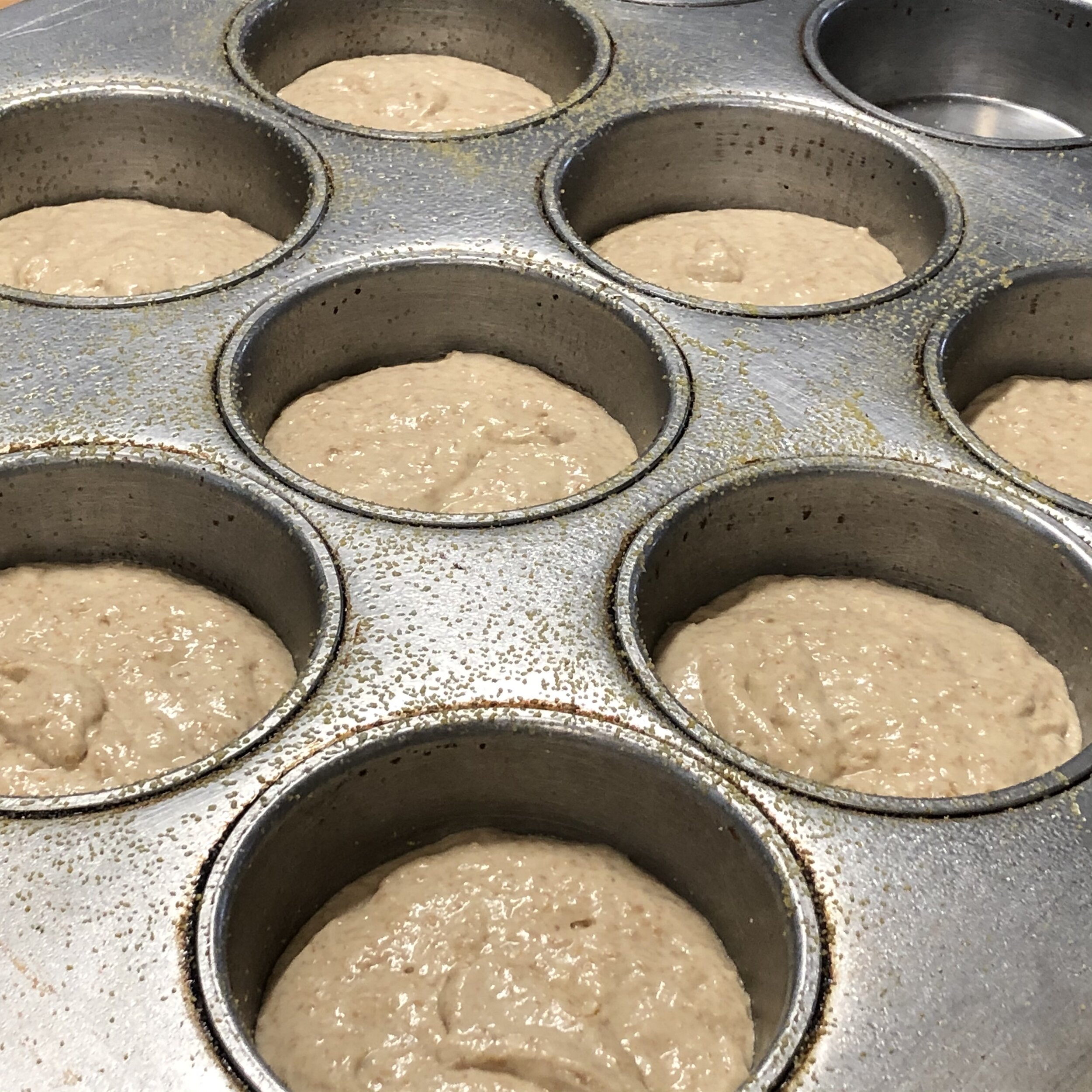
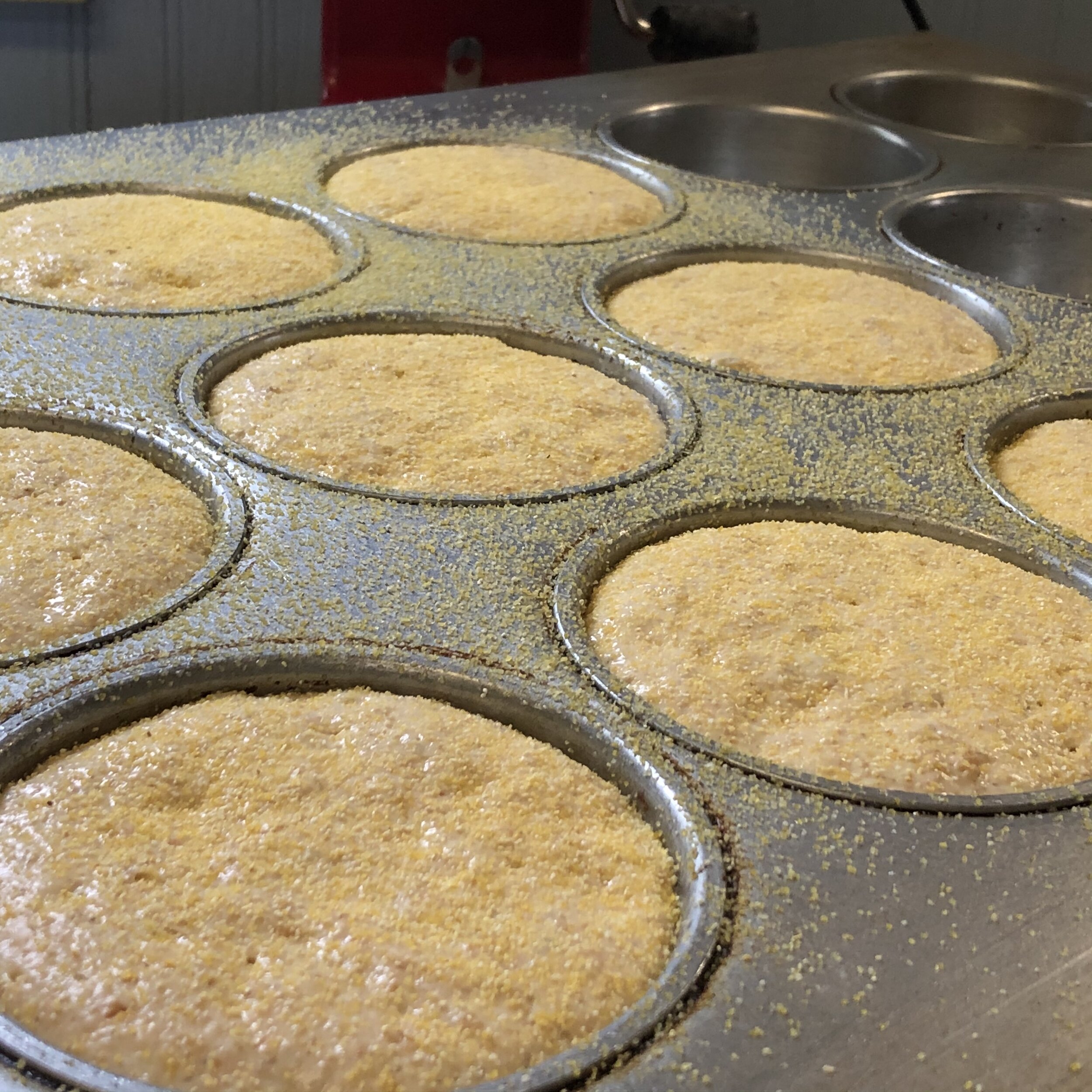


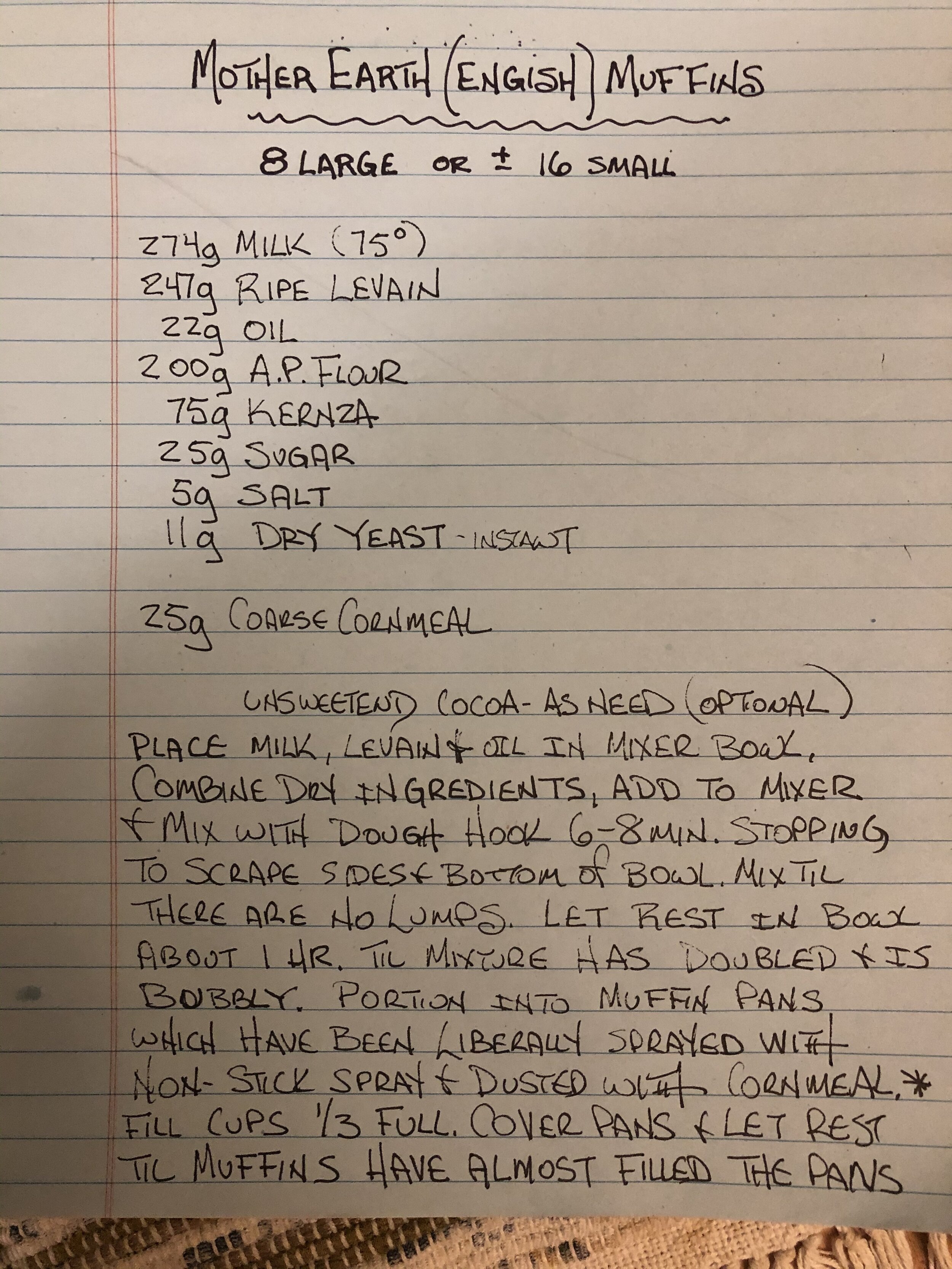
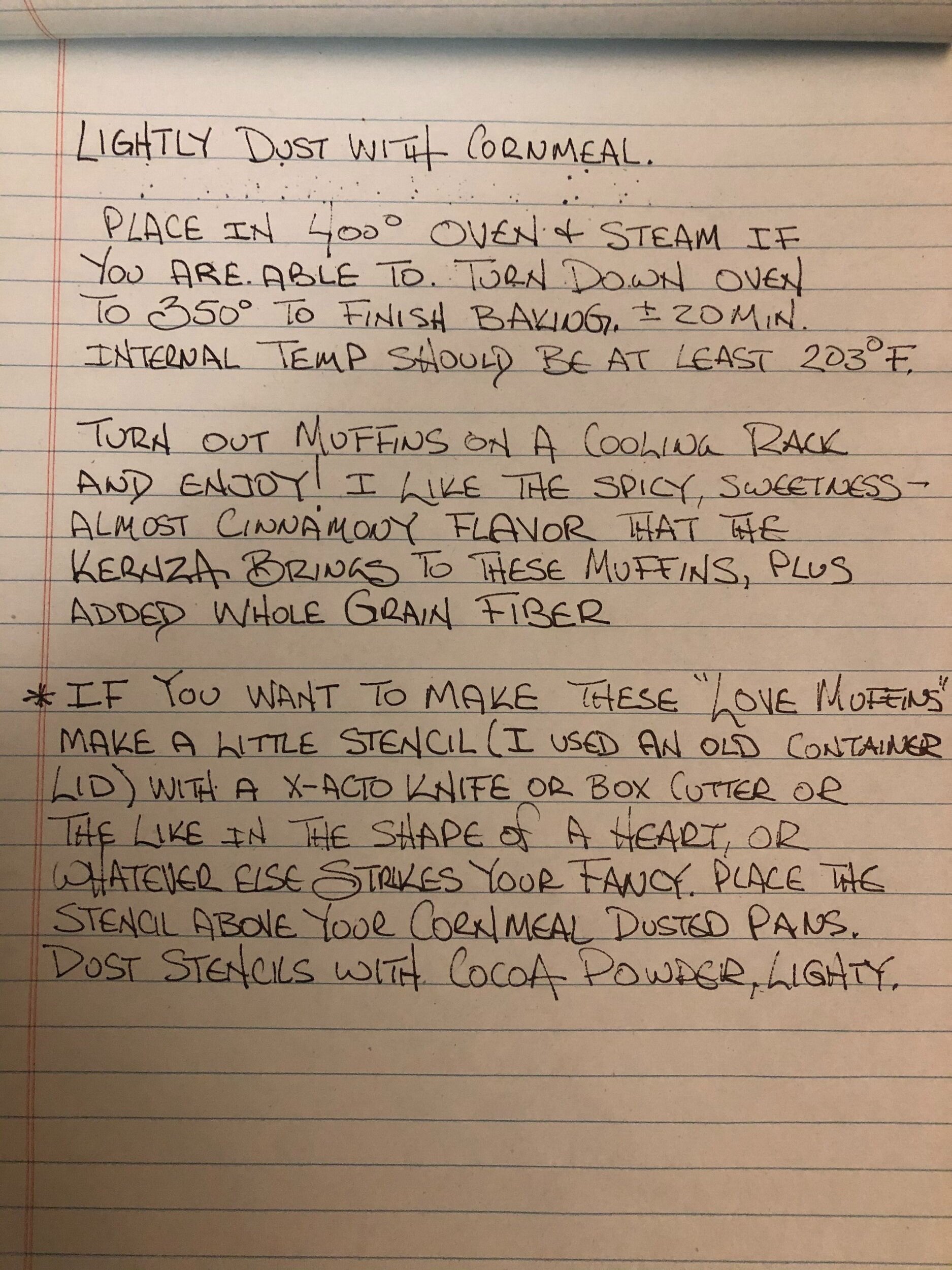
Recipe: Mother Earth (English) Muffins
Makes 8 large or 16 small muffins
Ingredients:
274g Milk (75 degrees)
247g Ripe Levain
22g Oil
200g All-purpose flour
75g Kernza(R) flour
25g Sugar
5g Salt
11g Dry Yeast—Instant
22g Coarse Cornmeal (for dusting)
Unsweetened Cocoa (optional)
Instructions:
Place milk, levain, and oil in mixer bowl.
Combine dry ingredients (flour, sugar, salt, and yeast) & add to mixer bowl.
Mix with dough hook for 6-8 minutes, stopping to scrape sides and bottom of bowl. Mix until there are no lumps.
Let mixture rest in bowl until it has doubled in size and is bubbly. (Approx ~ 1 hour)
Prepare muffin pan by liberally greasing and dusting with cornmeal.
Portion mixture into muffin pan. Fill only 1/3 of each muffin mold
Cover the filled muffin pans and let rest until mixture has almost filled each mold.
Lightly dust with cornmeal.
Place in oven at 425 degrees (with steam if able) and bake 5 minutes.
Drop the oven temperature to 350 degrees and bake for ~20 additional minutes. The internal temperature should be at least 203 degrees.
Turn out muffins on a cooling rack and enjoy!
Optional “Love Muffins”: Make a stencil with an old container lid in the shape of a heart (or anything else you fancy) and place it over each muffin mold after dusting it with cornmeal. Lightly dust cocoa powder over each stencil.
Share your Kernza(R) baking experience with us! Email photos and reactions to info@lakepepinlegacyalliance.org
Kernza Kuchen
Created by: Sandra Thielman, Smiling Pelican Bakeshop

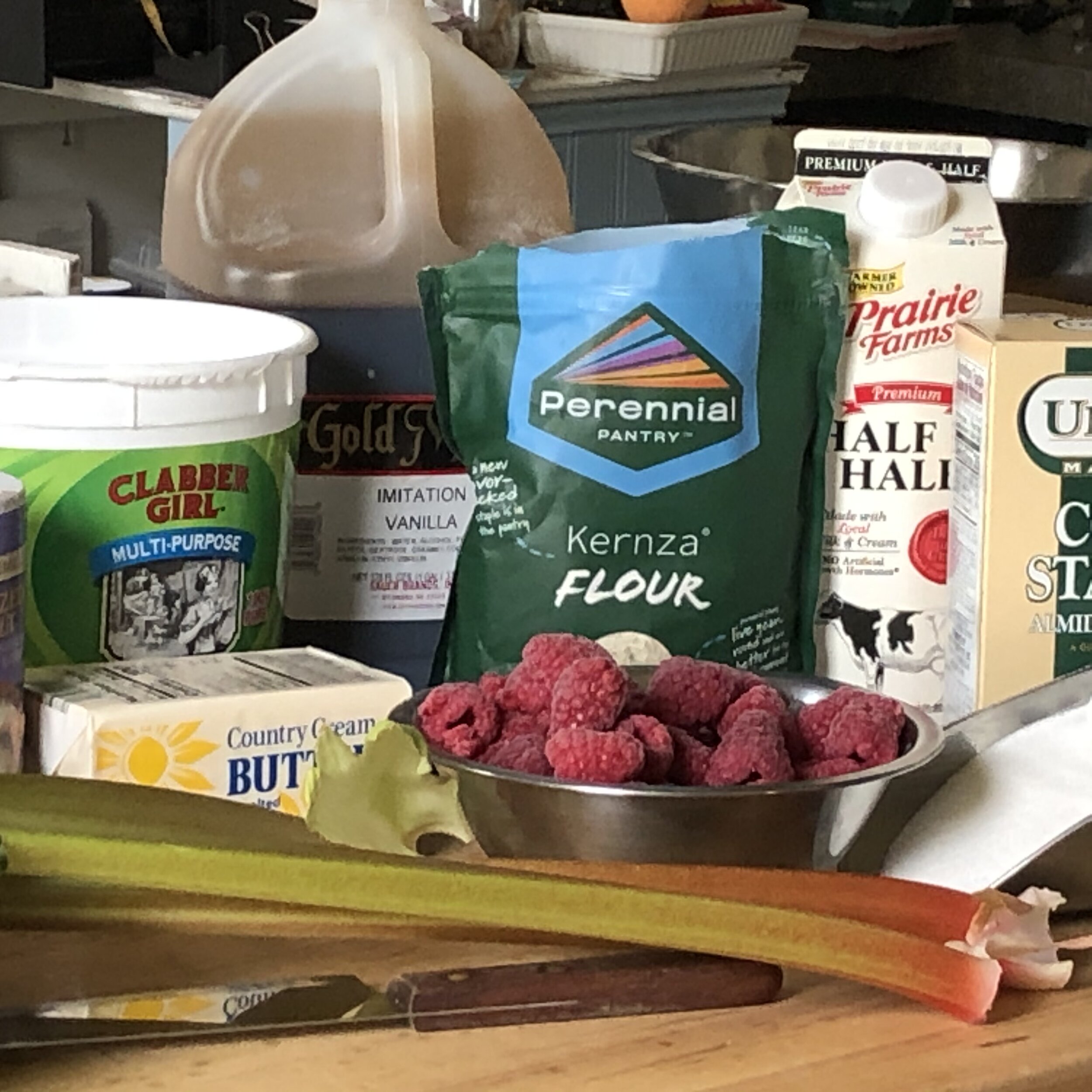
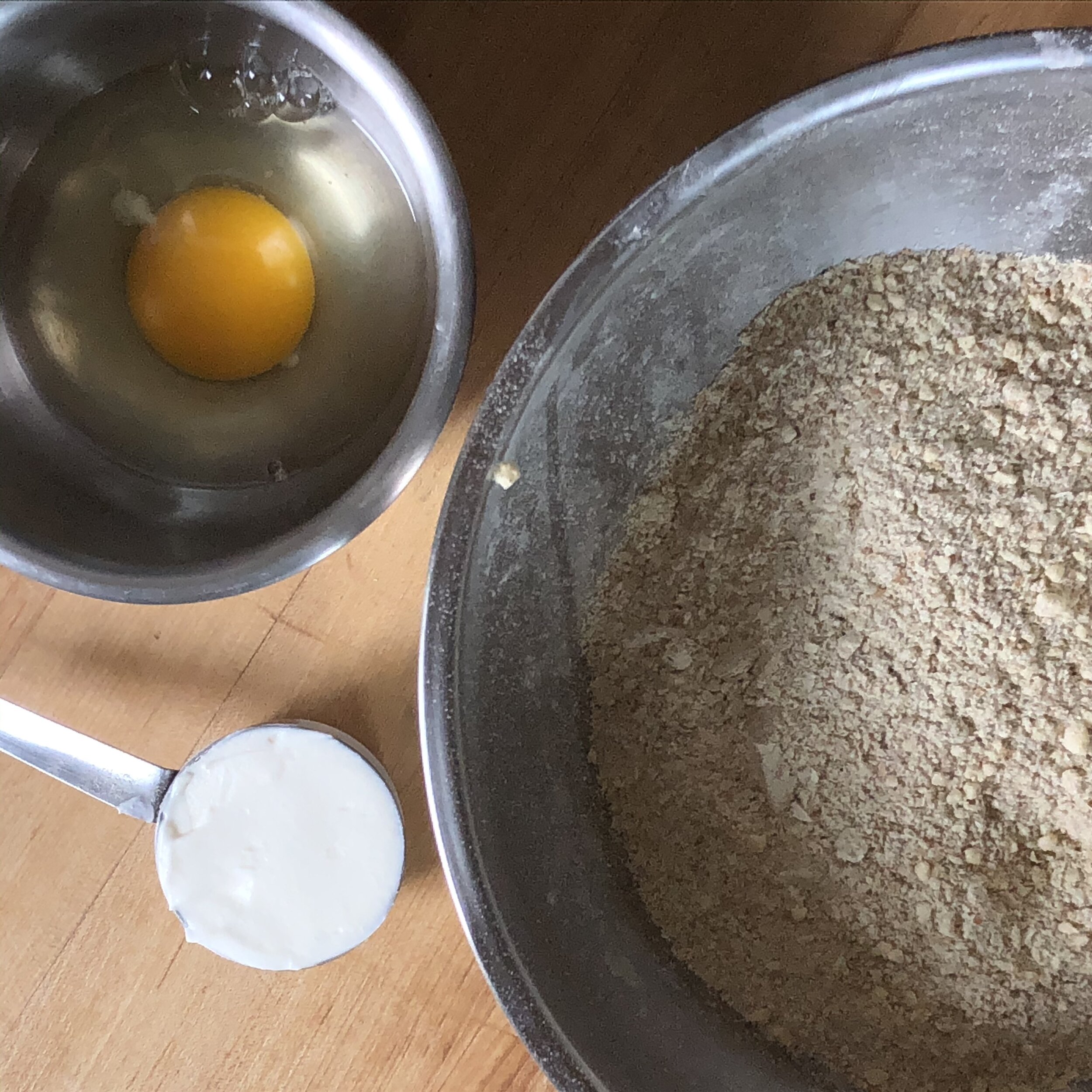
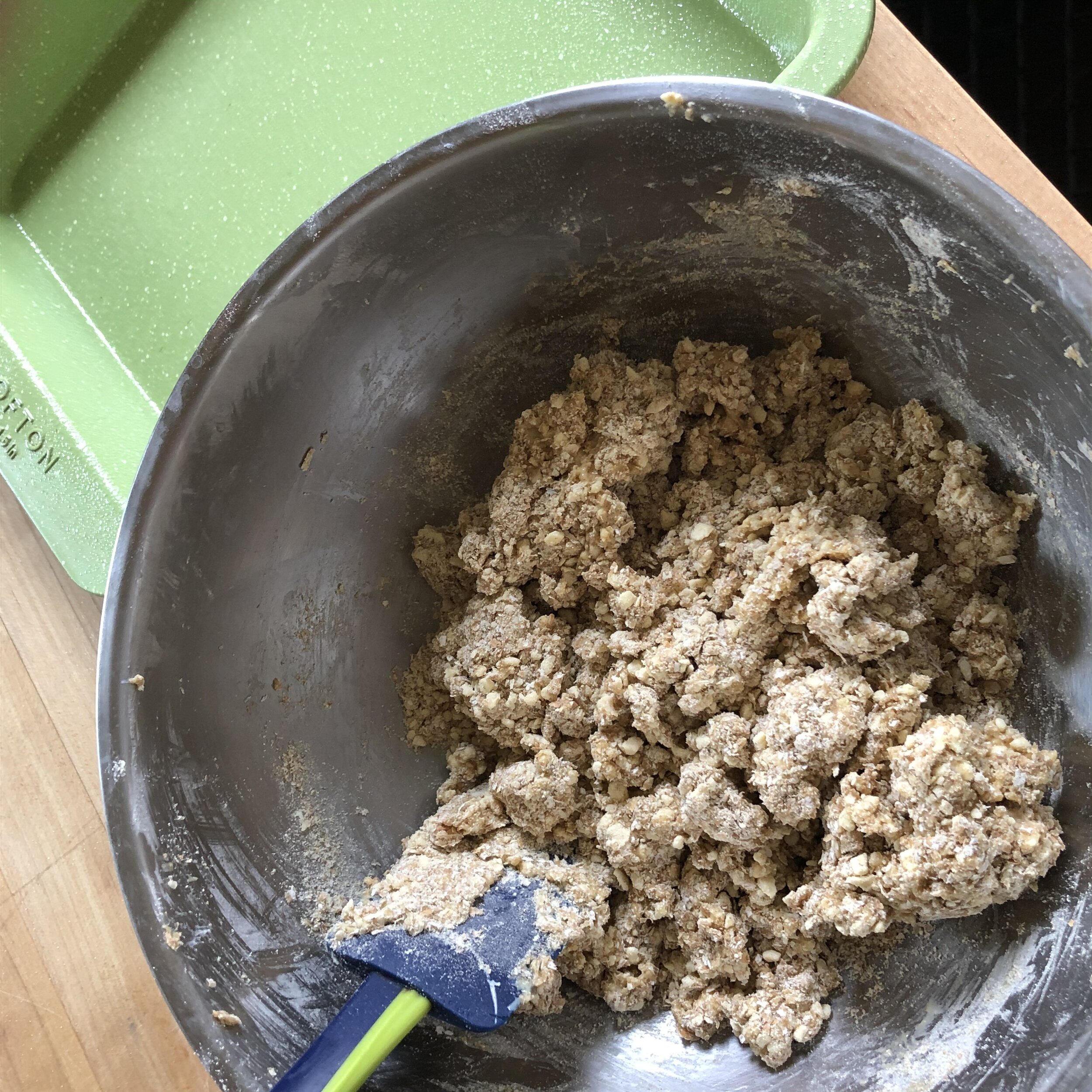
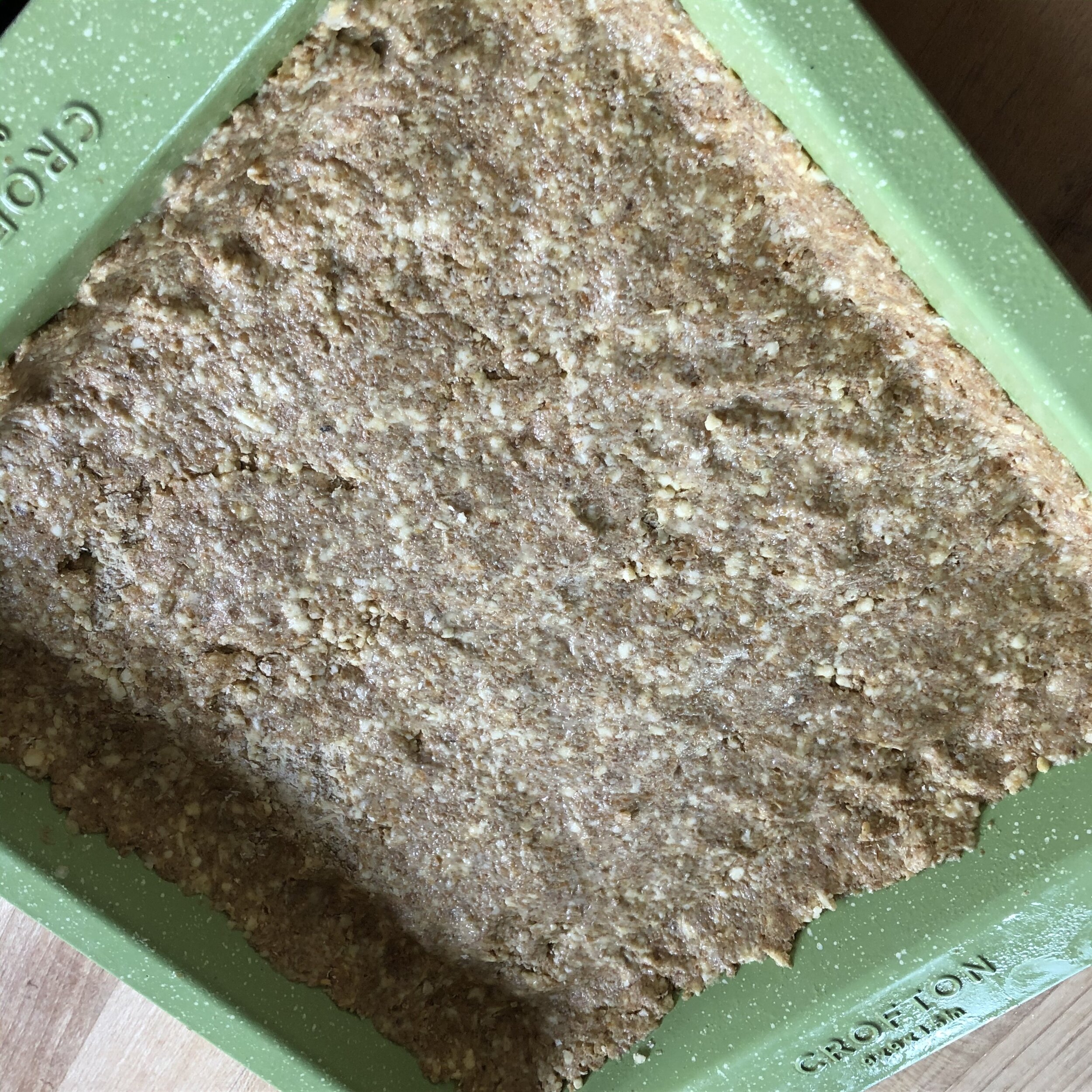
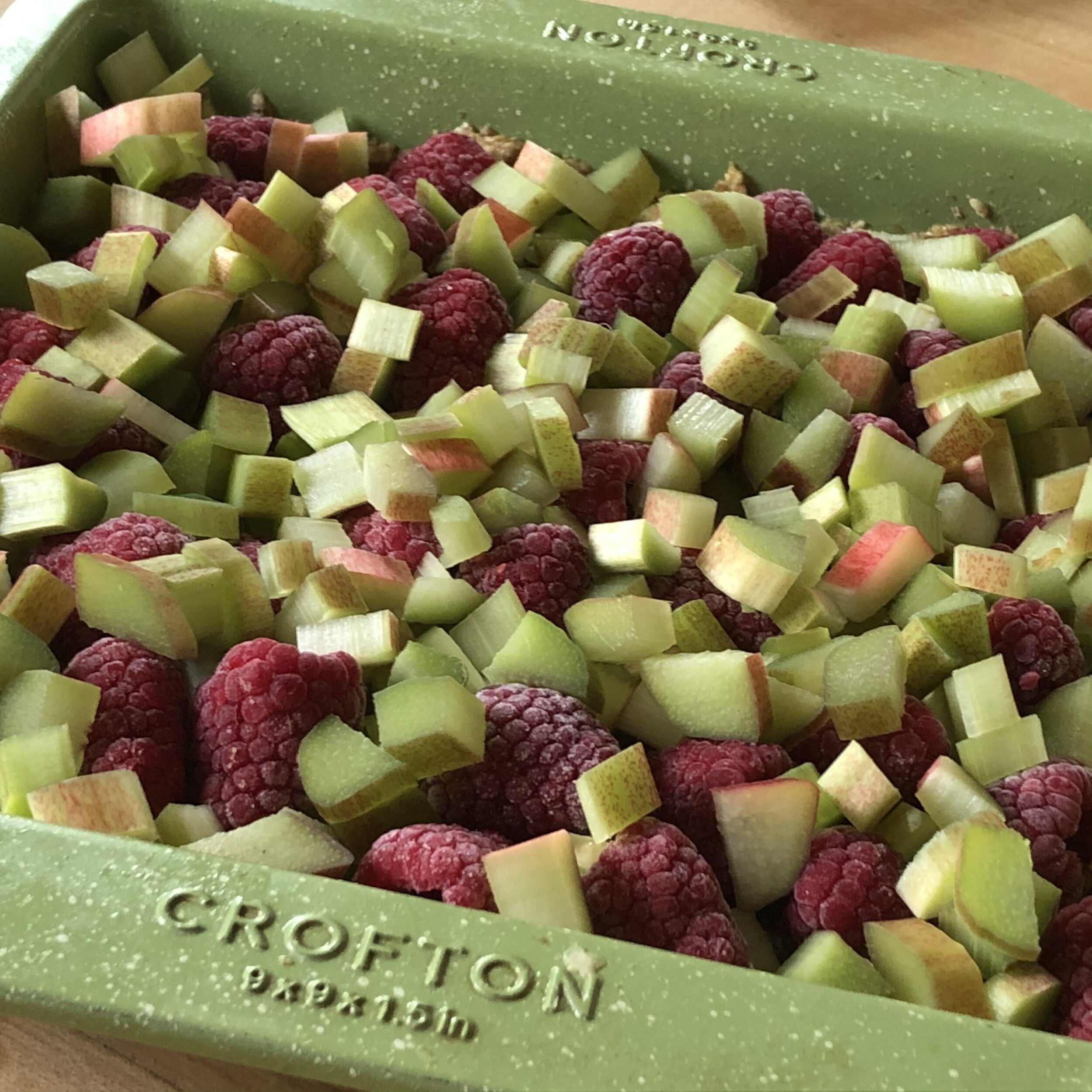
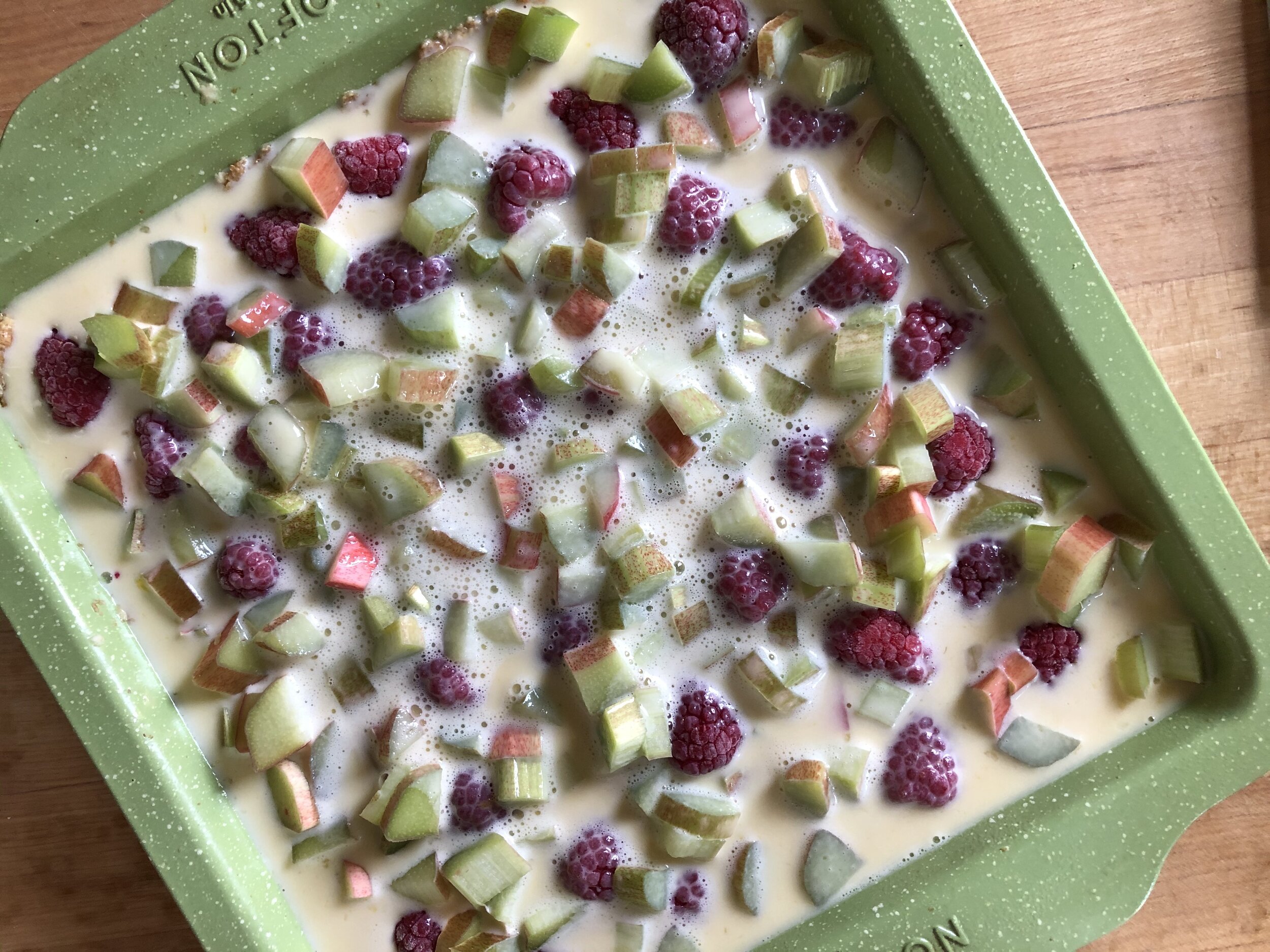
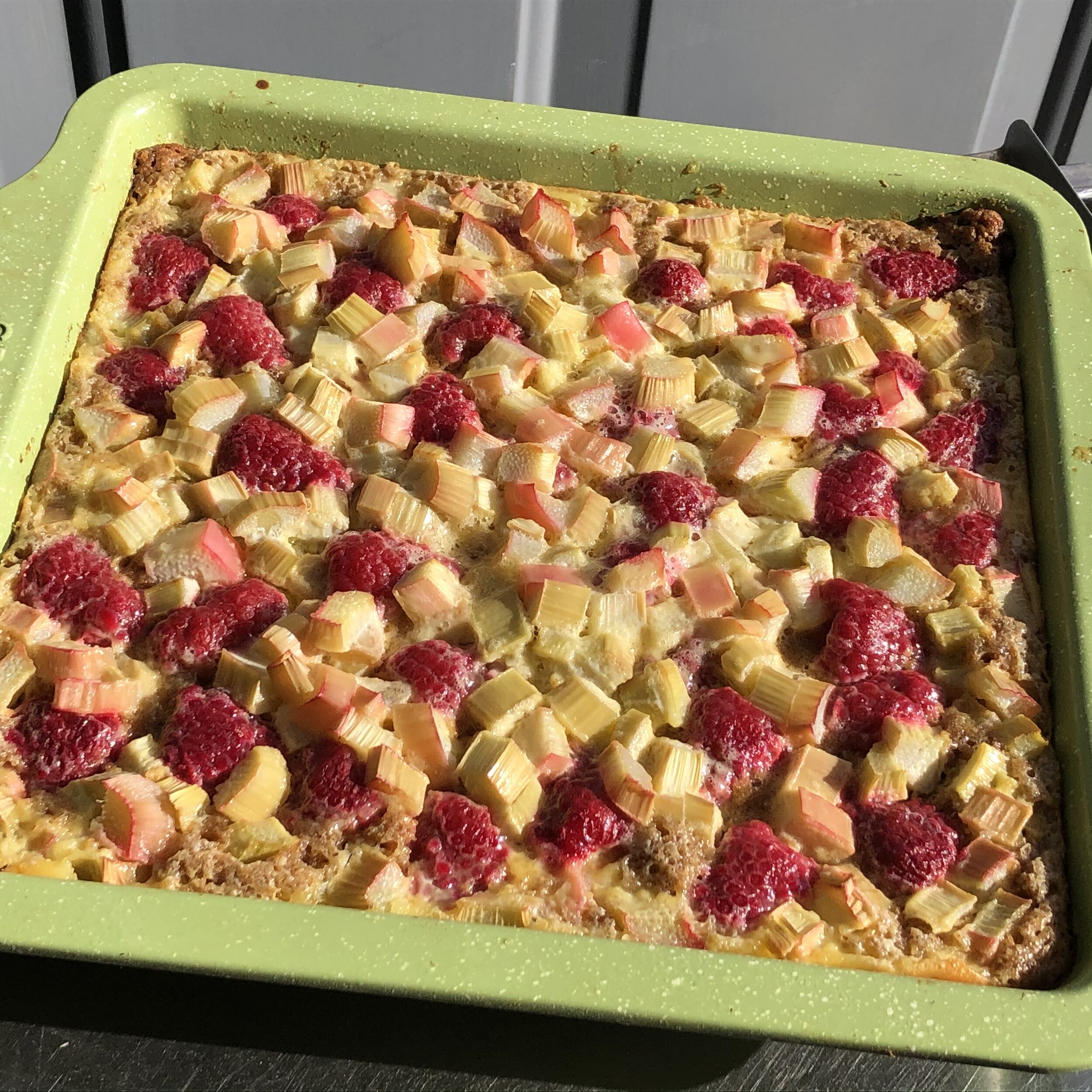
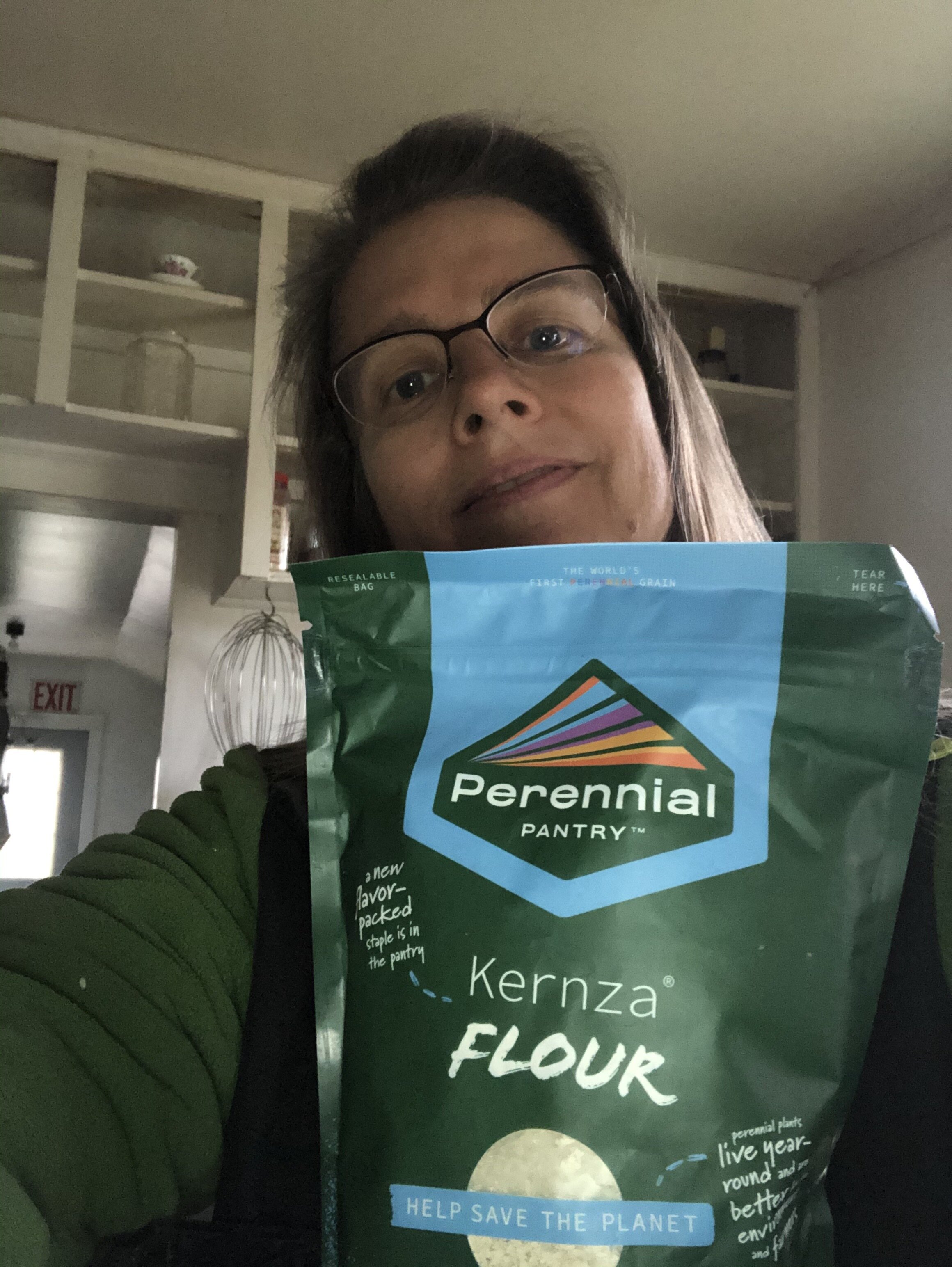
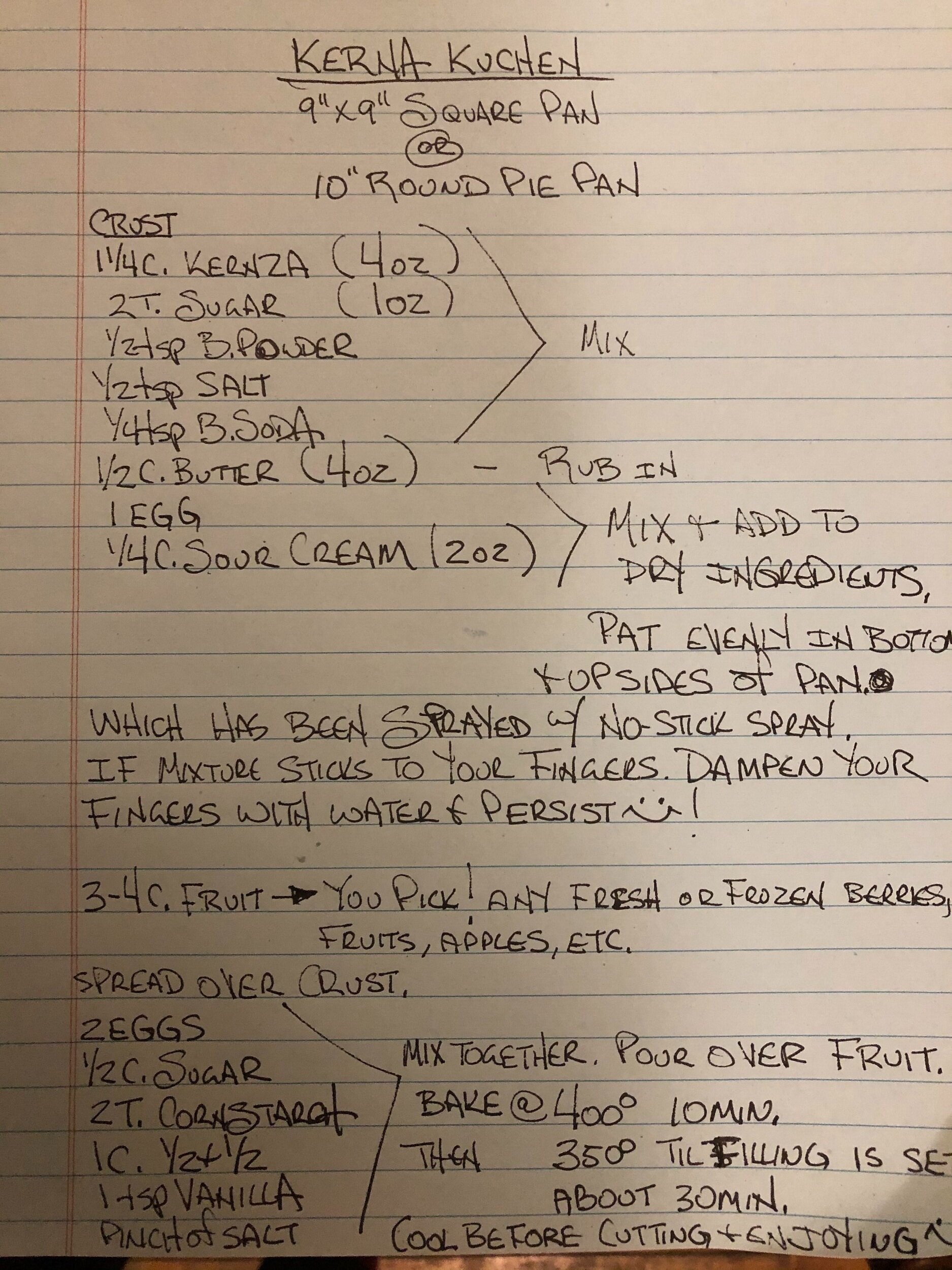
Recipe: Kernza(R) Kutchen
Makes 1 Pan (9”x9” Square or 10” Round)
Crust Ingredients:
1 1/4 c. Kernza(R) flour
2 T. Sugar
1/2 tsp. Baking Powder
1/4 tsp. Baking Soda
1/2 c. Butter
1 Egg
1/4 c. Sour Cream
Filling Ingredients:
3-4 c. of fruit (your choice!)
2 Eggs
1/2 c. Sugar
2 T. Cornstrarch
1 c. Half & Half
1 tsp. Vanilla
Pinch of salt
Instructions:
Grease pan with non-stick spray.
Mix dry ingredients together (flour, sugar, baking power, & baking soda)
Cut butter and rub into the dry mixture.
In a separate bowl, mix egg and sour cream. Then add to the dry ingredients.
Place the combined crust mixture into grease pan and pat evenly across the bottom and up the sides. If mixture sticks to your fingers, then dampen your fingers with water and persist!
Add fruit on top of crust. You can use frozen or fresh. Larger fruit will need to be cut into chunks beforehand.
Mix the rest of the filling ingredients together in separate bowl: eggs, sugar, cornstarch, half & half, vanilla, and salt. Then, pour filling over fruit in the pan.
Bake at 400 degrees for 10 minutes.
Lower temperature to 350 degrees and continue baking until filling is set. Approx. ~ 30 minutes.
Cool before cutting & Enjoy!
Share your Kernza(R) baking experience with us! Email photos and reactions to info@lakepepinlegacyalliance.org
Clean Water Kitchen: Kernza(R) Recipes from Judy Krohn
We teamed up with our local friends and kitchen extraordinaires to share a few Kernza(R) recipes straight from the shores of Lake Pepin! Judy Krohn created a Kernza(R) Grain Salad with Kale & Bacon, a Mediterranean Chicken & Kernza Skillet, and Seeded Parmesan Grissini.
Try them at home and share your experience with us to win a Kernza(R) prize package from Perennial Pantry and Minnesota Institute for Sustainable Agriculture!
Kernza(R) Salad w/ Kale & Bacon
Created by: Judy Krohn
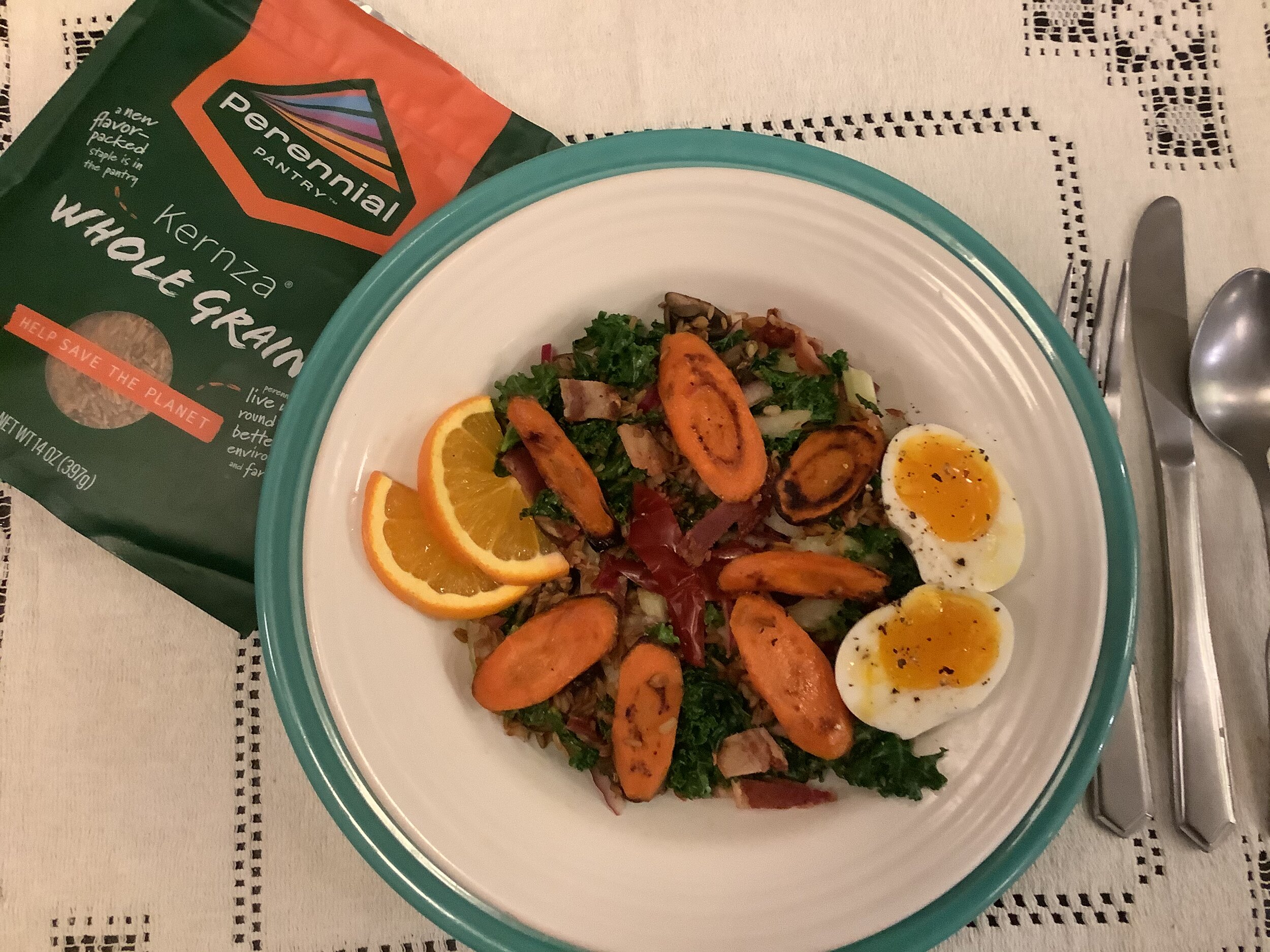
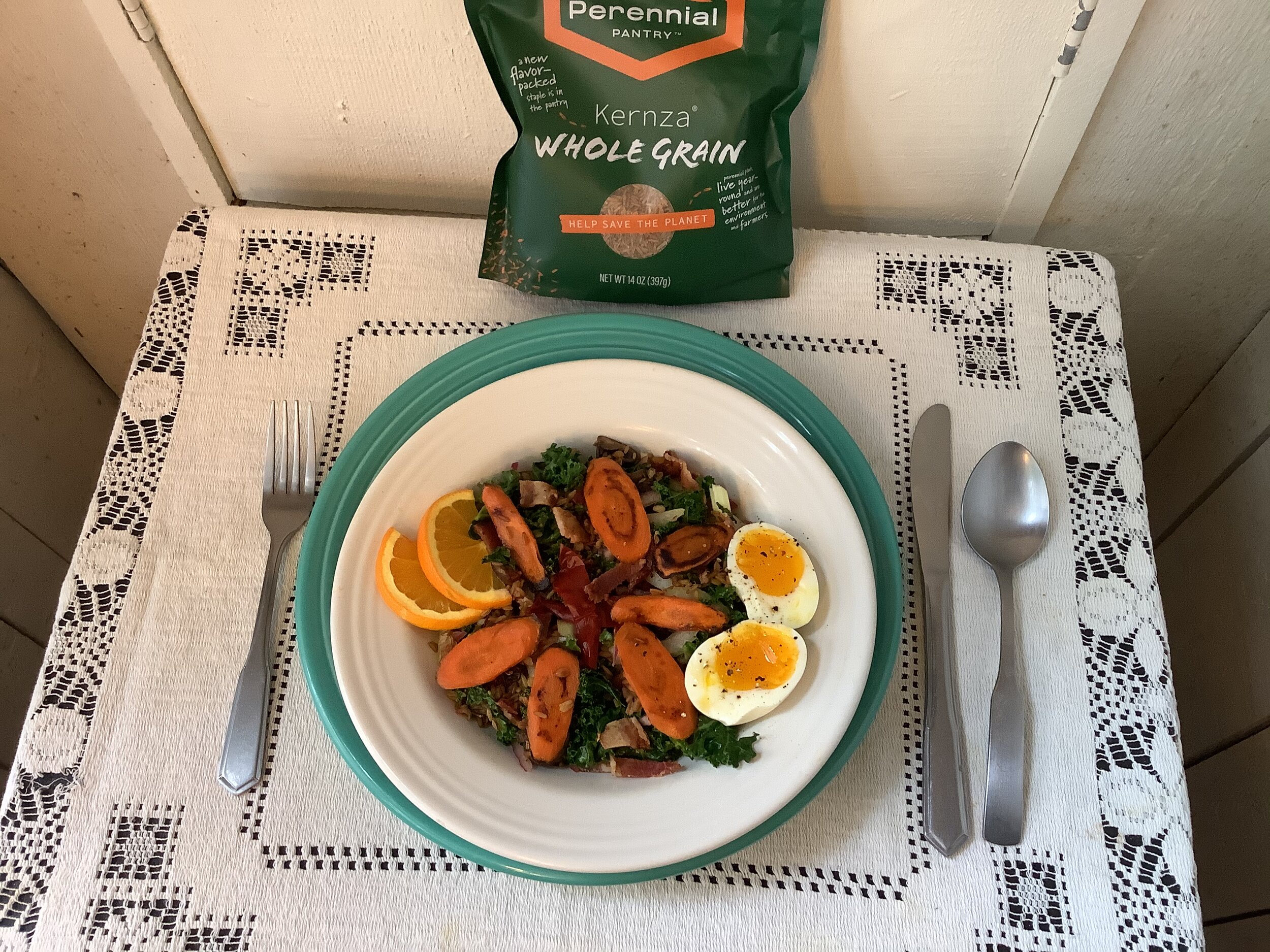
Recipe: Kernza(R) Salad w/ Kale & Bacon
2 main-dish servings (or 3-4 smaller ones)
Ingredients:
4 strips of thick-cut bacon
1/2 cup thinly sliced red onion
2 cloves of garlic, sliced
1 T. Dijon mustard
2 T. Maple Syrup (or honey)
1/4 cup lemon juice or apple cider vinegar
4 stalks of kale, greens stripped off and sliced
2 cups of cooked whole Kernza(R)
Salt and Pepper
1 cup of pan-seared carrots
2 soft-boiled eggs (I do 7 minutes)
Instructions:
Cook the bacon in a skillet until crispy; drain on paper towels and crumble or chop into small pieces.
To the bacon fat in the skillet, add the red onion and garlic and cook over medium heat until just wilted, but still a bit crisp.
Stir in the mustard, syrup and lemon juice and bring to a boil.
Add the kale, cover and steam until just barely wilted.
Stir in the cooked Kernza (R) grain and crumbled bacon.
Taste for seasoning and add salt and pepper to your taste.
Transfer the salad to individual bowls or plates, and garnish with some pan-seared carrots and eggs. Best served warm or at room temperature.
If you like, you can substitute Turkey Bacon in the salad; perhaps add a little more olive oil to compensate for the leaner meat. You can make this vegetarian by omitting the bacon, of course. Just warm 3-4 T. olive oil, saute the veggies as directed. 1/4-1/2 t. smoked paprika can be added to the dressing for that smokey taste. Or, add slivers of a smoked cheese (Gouda or Provolone).
Share your Kernza(R) baking experience with us! Email photos and reactions to info@lakepepinlegacyalliance.org
Mediterranean Chicken & Kernza(R) Skillet
Created by: Judy Krohn
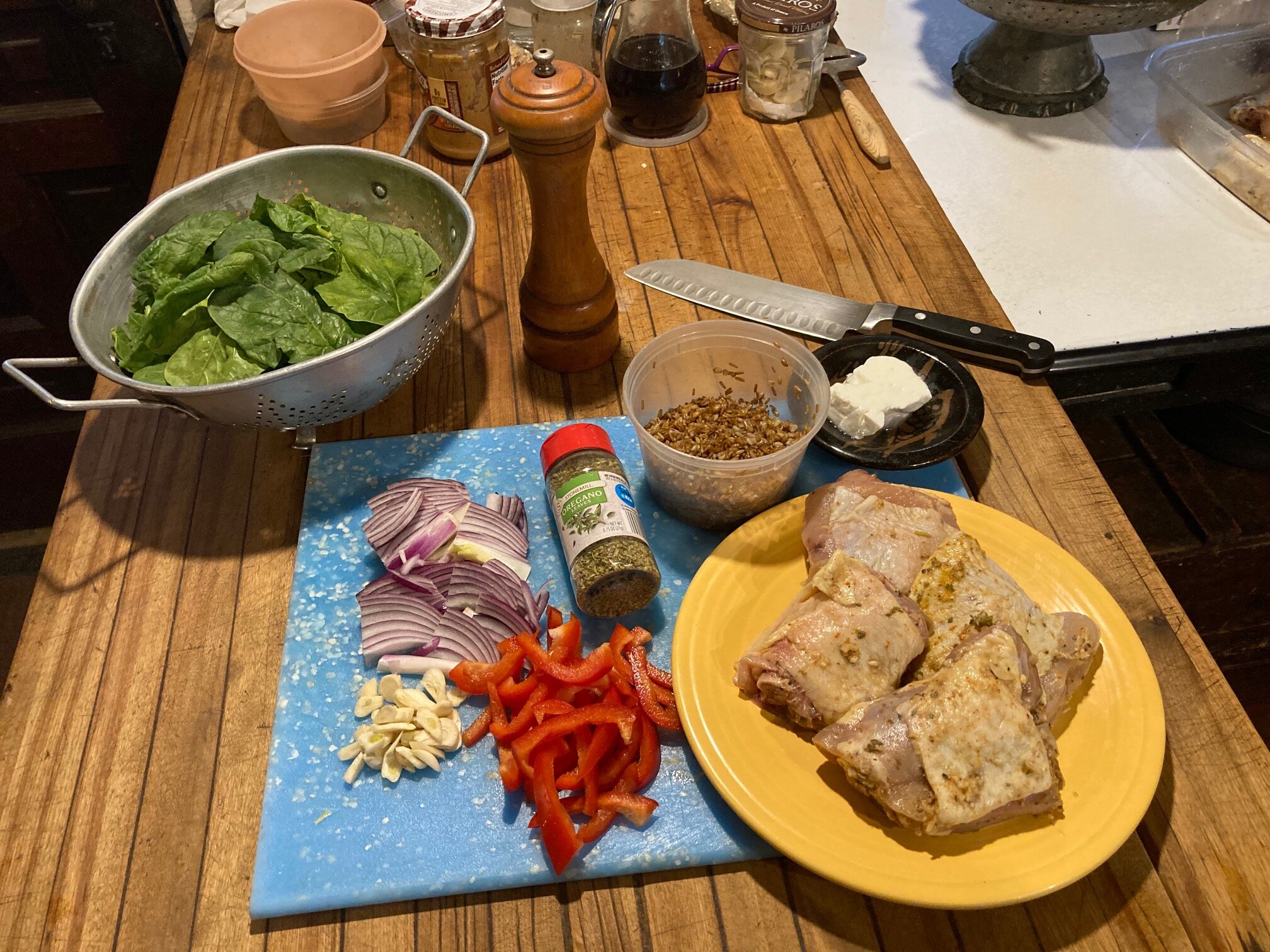
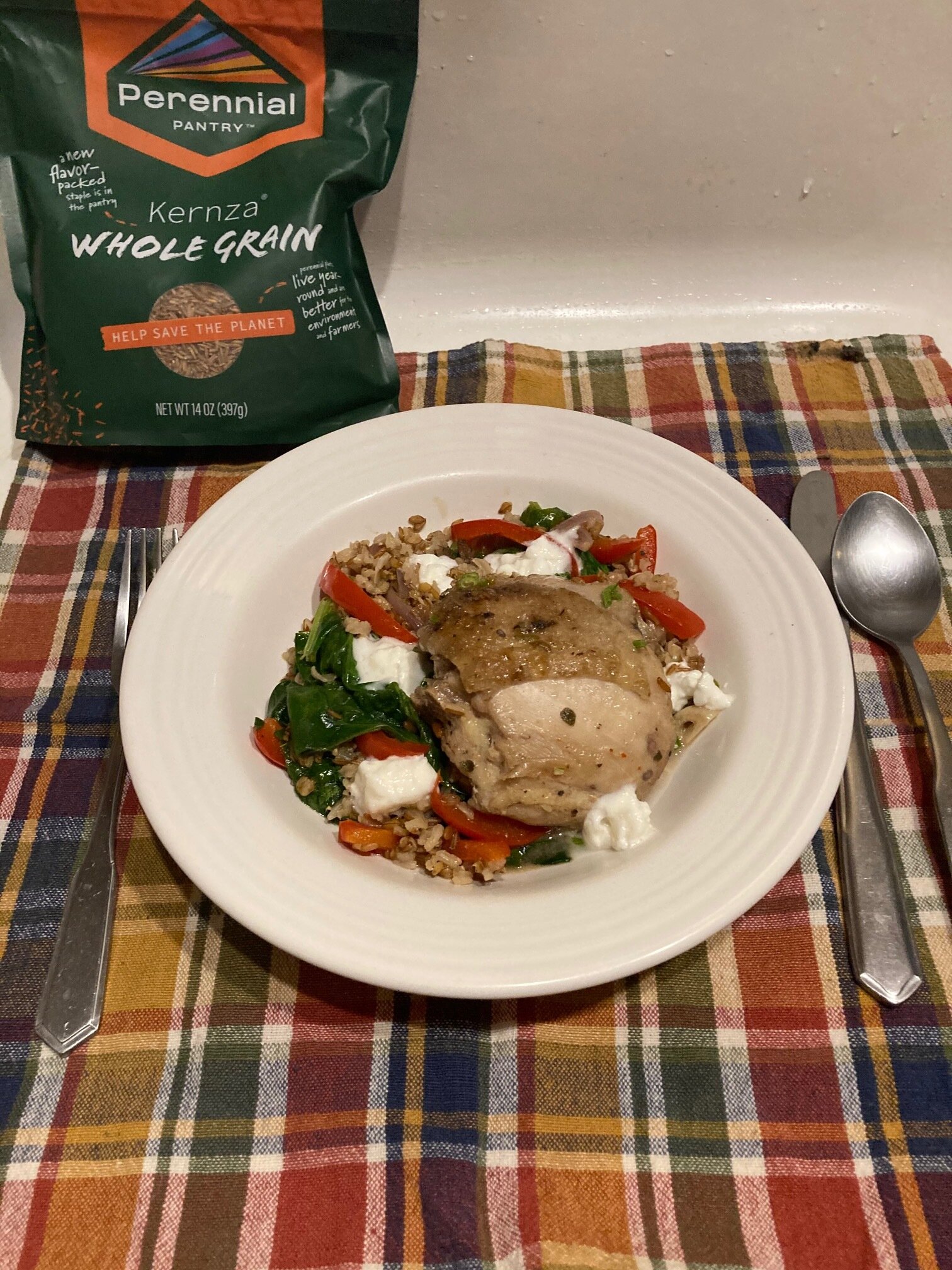
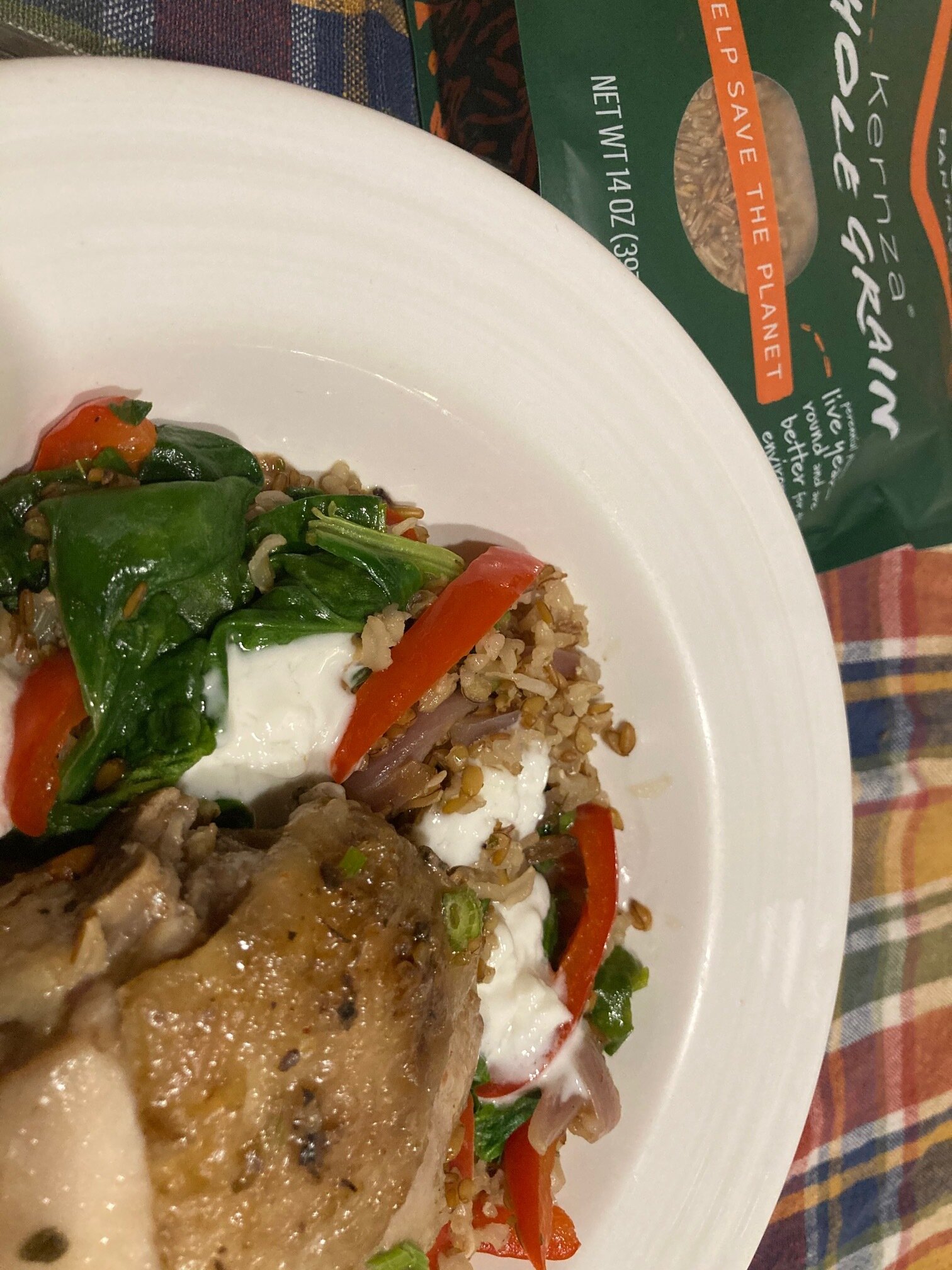
Recipe: Mediterranean Chicken & Kernza(R) Skillet
(4 Servings)
Crust Ingredients:
4 bone-in, skin on chicken thighs
Salt and Pepper
Olive oil
1 medium red onion, halved (pole-to-pole) and thinly sliced
3-4 cloves of garlic, peeled and sliced
1/2 t. dried oregano (or 1 t. fresh, if you have it)
A pinch of dried pepper flakes or cayenne pepper (optional)
1/2 cup chicken broth or white wine (I used some of each)
2 cups cooked Whole Kernza(R)
1/2 fresh red bell pepper, thinly sliced
4 cups fresh spinach (roughly chopped if leaves are large)
1/2 cup crumbled feta cheese
Instructions:
Trim excess fat from the chicken thighs and season all over with some salt and pepper.
Heat a 10” skillet over medium-high heat and add the chicken, skin-side down. Cook for 5 minutes, or until nicely browned; turn and cook 2-3 minutes on the other side. Remove the chicken from the pan and set aside, covered to keep warm.
Add a little more oil to the skillet and stir in the onion, garlic, oregano and pepper flakes (if using). Cook and stir until softened; then de-glaze the pan with the broth and/or wine, scraping up the browned bits in the pan.
Add the cooked Kernza(R) grain, nestle the chicken (and any juices) back into the pan, skin-side up. Cover and cook over medium-low heat until the chicken reaches an internal temperature of 165 degrees, 15-20 minutes.
Remove the chicken once more; stir the red pepper and spinach into the skillet and cook until just wilted.
Put the chicken back on top of the skillet mixture; turn off the heat and sprinkle the feta cheese over the chicken.
Cover and let the mixture stand until the cheese melts a little—5 minutes or so—before serving.
You can use kale or other greens instead of spinach (right now, I might substitute nettles and ramp leaves); adjust cooking times to be sure they are just tender.
Share your Kernza(R) baking experience with us! Email photos and reactions to info@lakepepinlegacyalliance.org
Seeded Parmesan Grissini
Created By: Judy Krohn

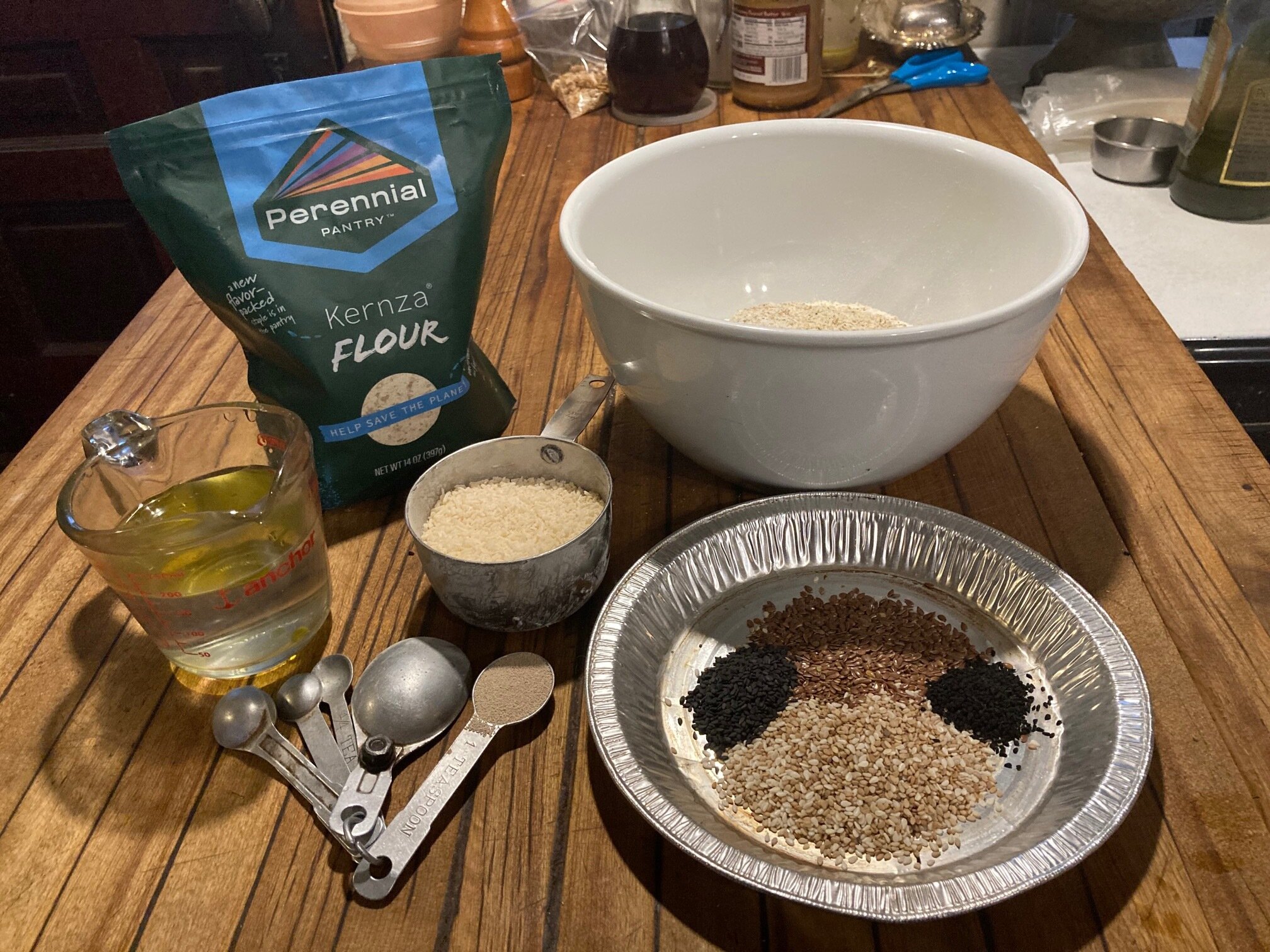
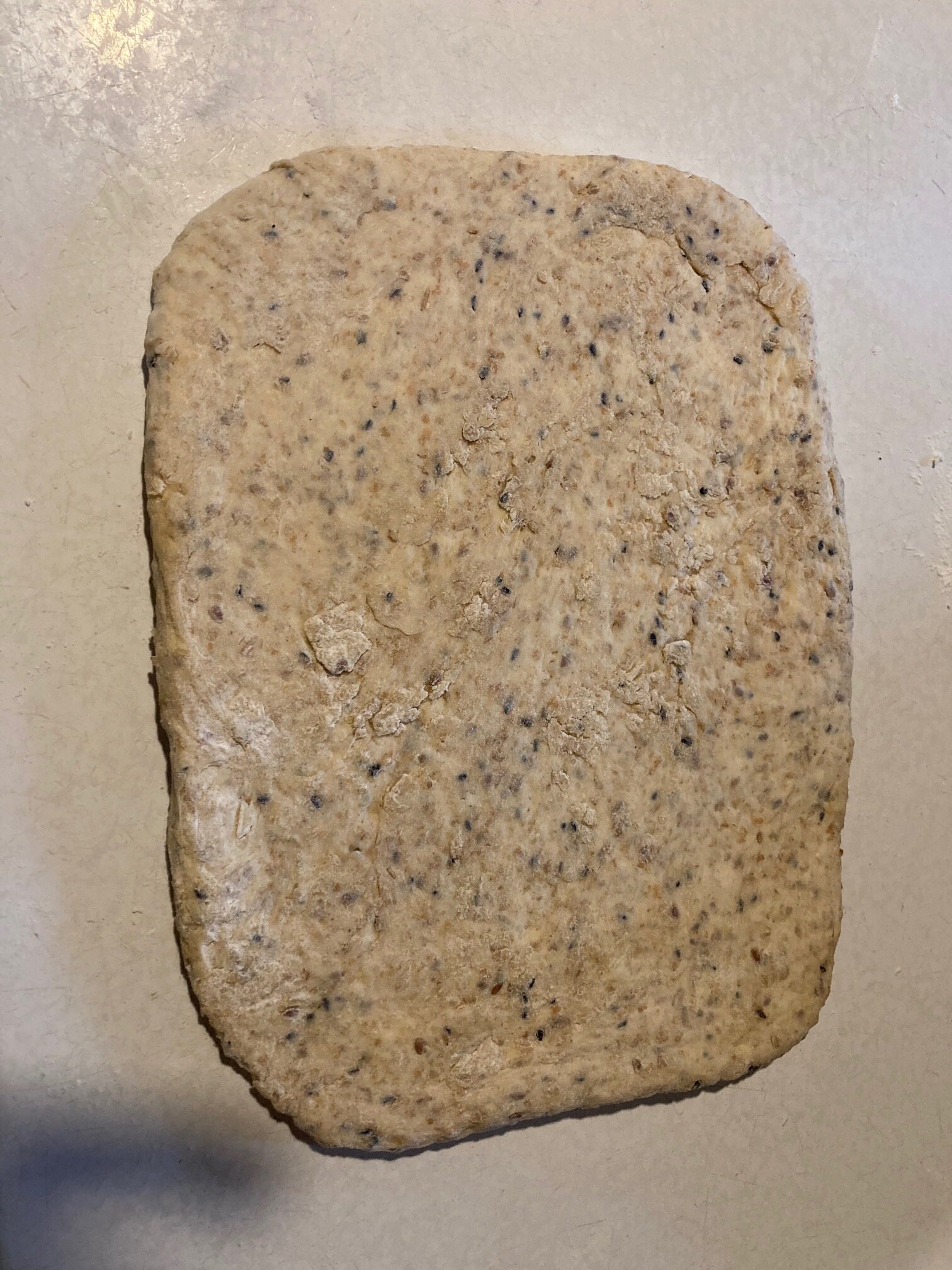
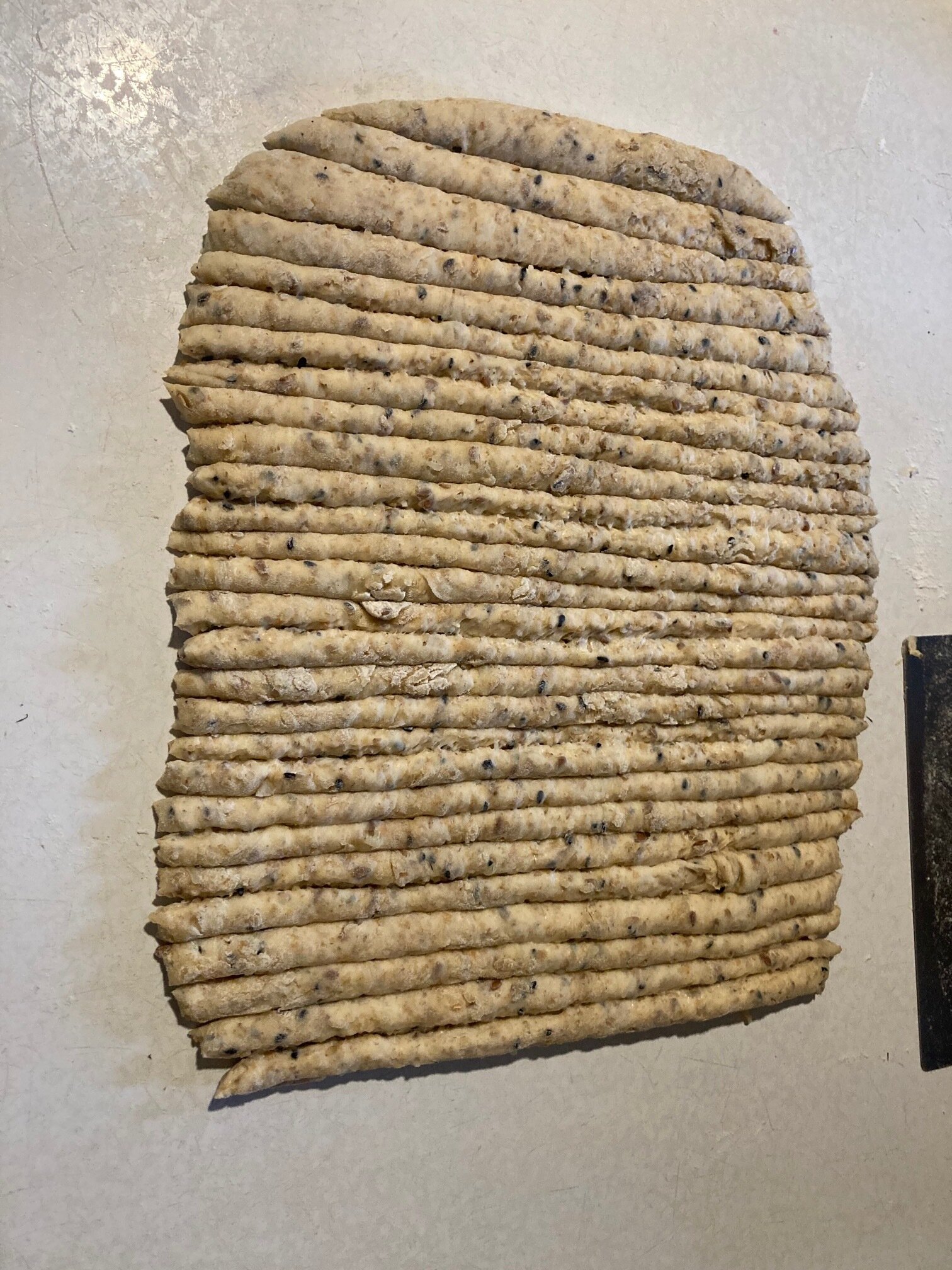
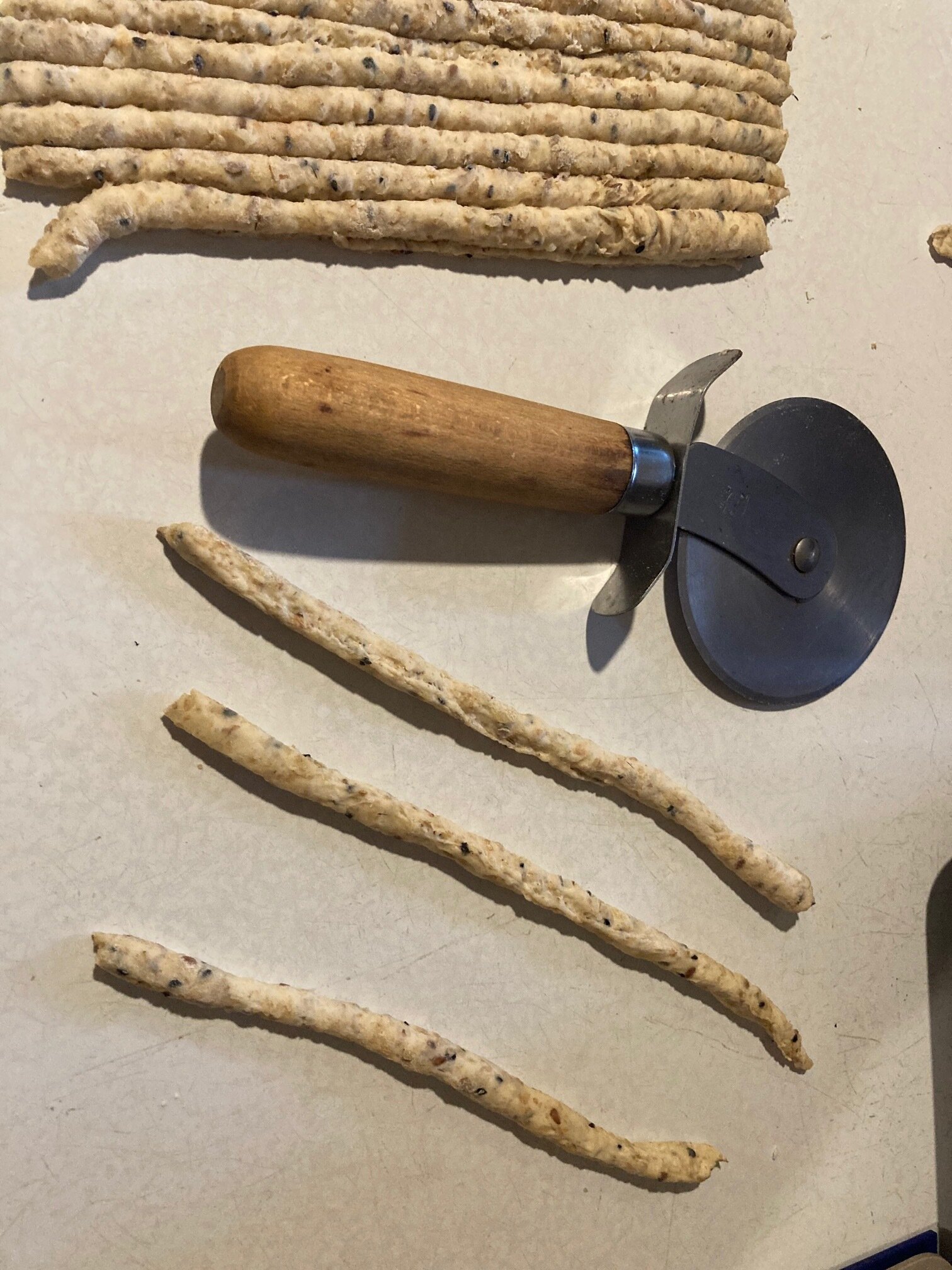
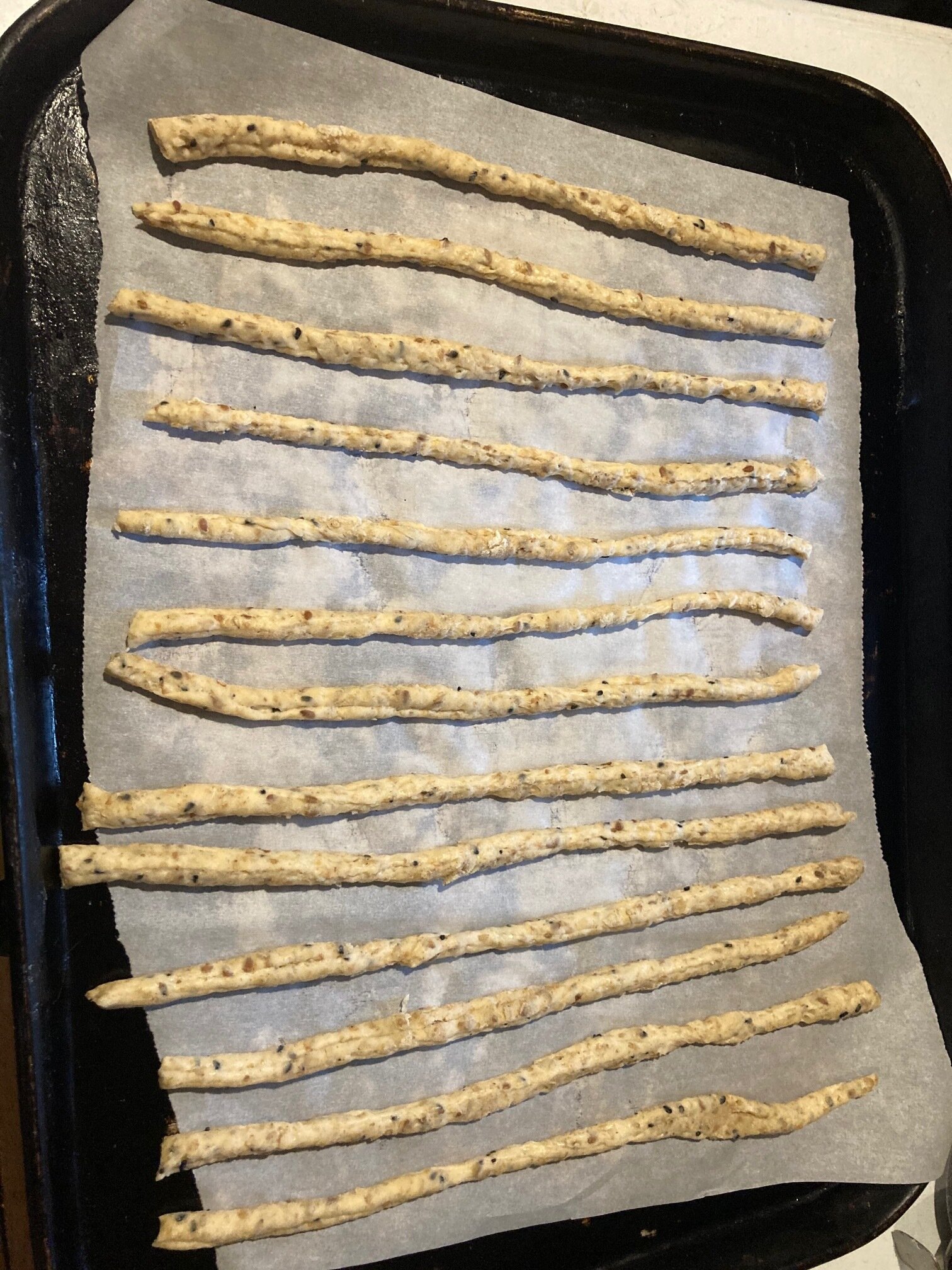
Recipe: Seeded Parmesan Grissini
(Makes about 50)
Ingredients:
1 3/4 cups all-purpose flour
1/2 cup Kernza flour
1 tsp. instant dry yeast
1 T. Kosher Salt + for sprinkle
1/3 cup mixed seeds (I used sesame, flax, nigella)
1 cup finely ground Parmesan cheese
A few grinds of fresh black pepper or a pinch of cayenne (optional)
3/4 cup warm water
2 T. olive oil
Instructions:
Combine flours, yeast, salt, seeds and Parmesan cheese in a medium bowl.
Mix the water and olive oil together and add to the flour mixture. Stir to combine, leaving no flour-y bits. (Add a little water, if necessary).
Turn the mixture out onto a lightly floured surface and knead together to form a cohesive ball.
Return the dough to the bowl, cover and let rise in a warm spot for 60-90 minutes, until doubled.
Preheat your oven to 400 degrees.
Turn dough out onto a table and flatten to an 8” x 4” rectangle. Use a pizza cutter to cut into 1/4” strips. Roll each strip a little thinner than a pencil.
Arrange the strips 1/2” apart on parchment-lined baking sheets. Sprinkle the strips with a little more kosher salt and bake until nicely browned, rotating baking sheets as necessary.
Share your Kernza(R) baking experience with us! Email photos and reactions to info@lakepepinlegacyalliance.org
Clean Water Kitchen: LPLA Staff & Board Try Kernza(R)!
It is an exciting time in the world of agriculture! Momentum is building towards a new paradigm of sustainable agriculture focused on covering the land with vegetation year-round. The idea of “Continuous Living Cover” (CLC) ensures crops are always on the land to mitigate nutrient leaching, absorb excess water, secure soil, and store carbon. The Land Institute and Forever Green Initiative at the University of Minnesota are leading the development of winter annuals and perennial crops that support CLC objectives while maximizing farm profitability and environmental benefits.
Kernza(R) is a new perennial grain creating tremendous buzz because of its deep root system and market potential. The dense roots can exceed 10 feet deep! Created by the Land Institute, Kernza(R) is the trademark name given to this intermediate wheatgrass (Thinopyrum intermedium), but new varieties are still being developed. The Forever Green Initiative at the University of Minnesota released its own Kernza(R) variety, called MN-Clearwater.
Kernza(R) is already being used in the “3 B’s”: breakfast, bread, and beer. And, just in the last year, Kernza(R) flour and grain became available for at-home baking and cooking! To celebrate, LPLA is promoting a Clean Water Kitchen Challenge from now until May 31st! Grab your own Kernza(R), experiment with some recipes, share your experience, and win a Kernza(R) prize package, including a Forever Green Cookbook from Minnesota Institute for Sustainable Agriculture (MISA) and Kernza (R) flour or grain from Perennial Pantry.
Learn more about the Clean Water Kitchen: Kernza(R) Baking Challenge here. Learn more: Kernza.org
For inspiration, the LPLA crew is experimenting with Kernza(R) in their own kitchens! LPLA ambassadors, Sandra Thielman (from Smiling Pelican Bakeshop) and Judy Krohn, created some special Kernza(R) recipes to share during Earth Week. And, LPLA staff and board share their baking adventures and recipe picks below.
Rylee’s Pick: Birchwood Cafe’s Kernza(R) Pancakes
Where to Find It: Beth Dooley on PBS NewsHour



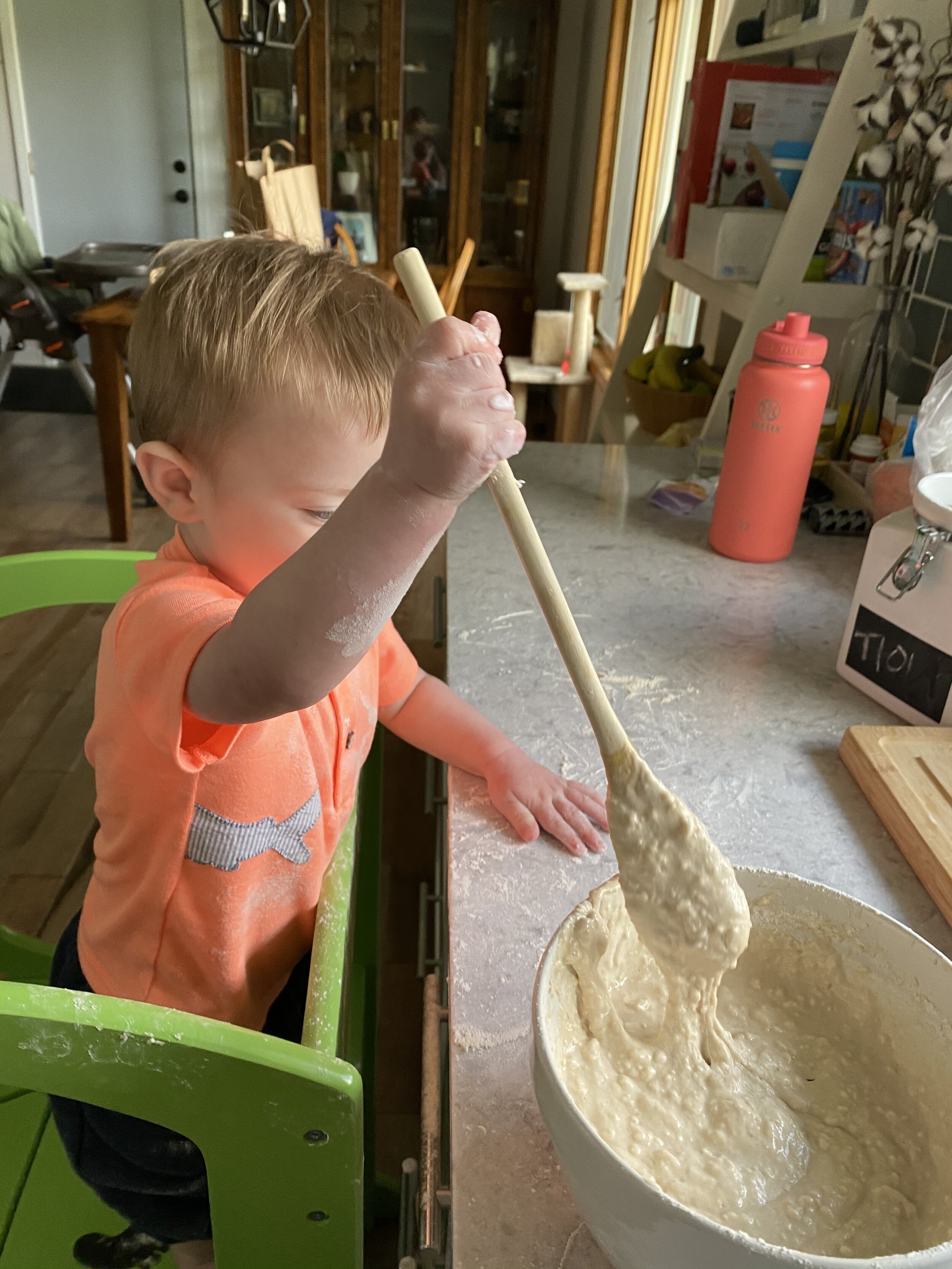

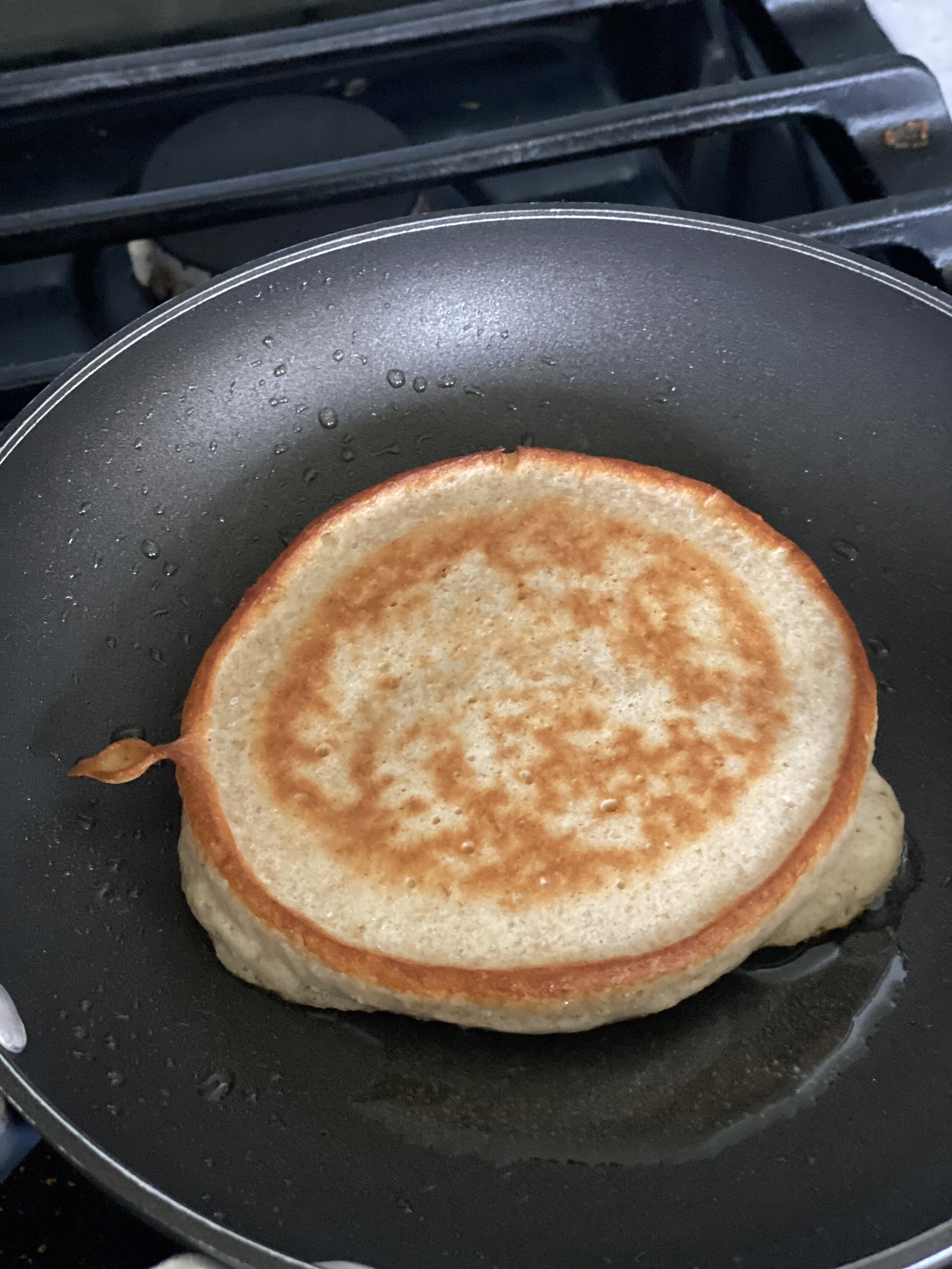

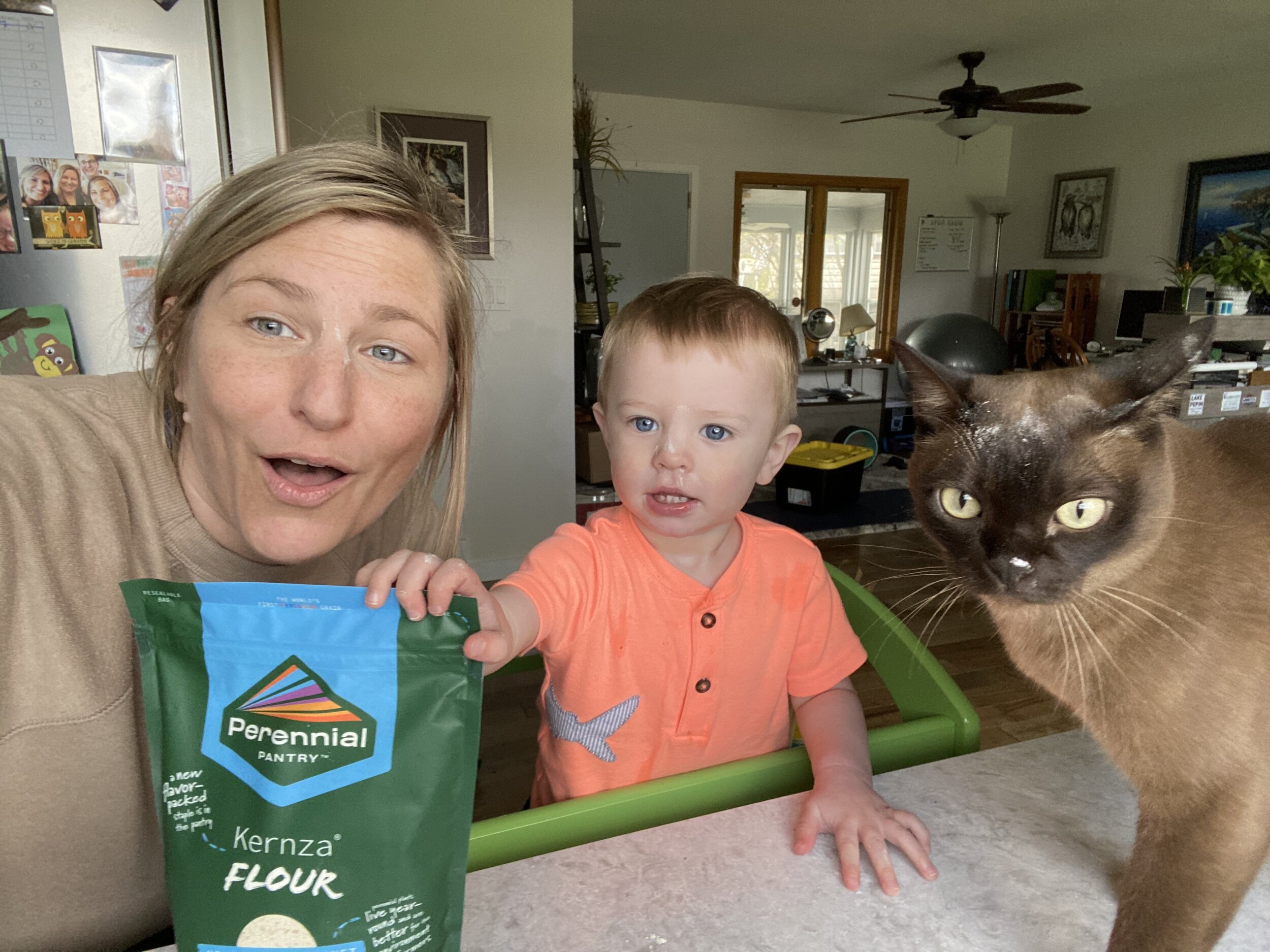
Doug’s Pick: Kernza(R) Drop Biscuits
Where to Find It: Perennial Pantry Community Recipes
Kenz’s Pick: Perennial Blueberry & Ginger Scones
Where to Find It: Perennial Pantry Community Recipes

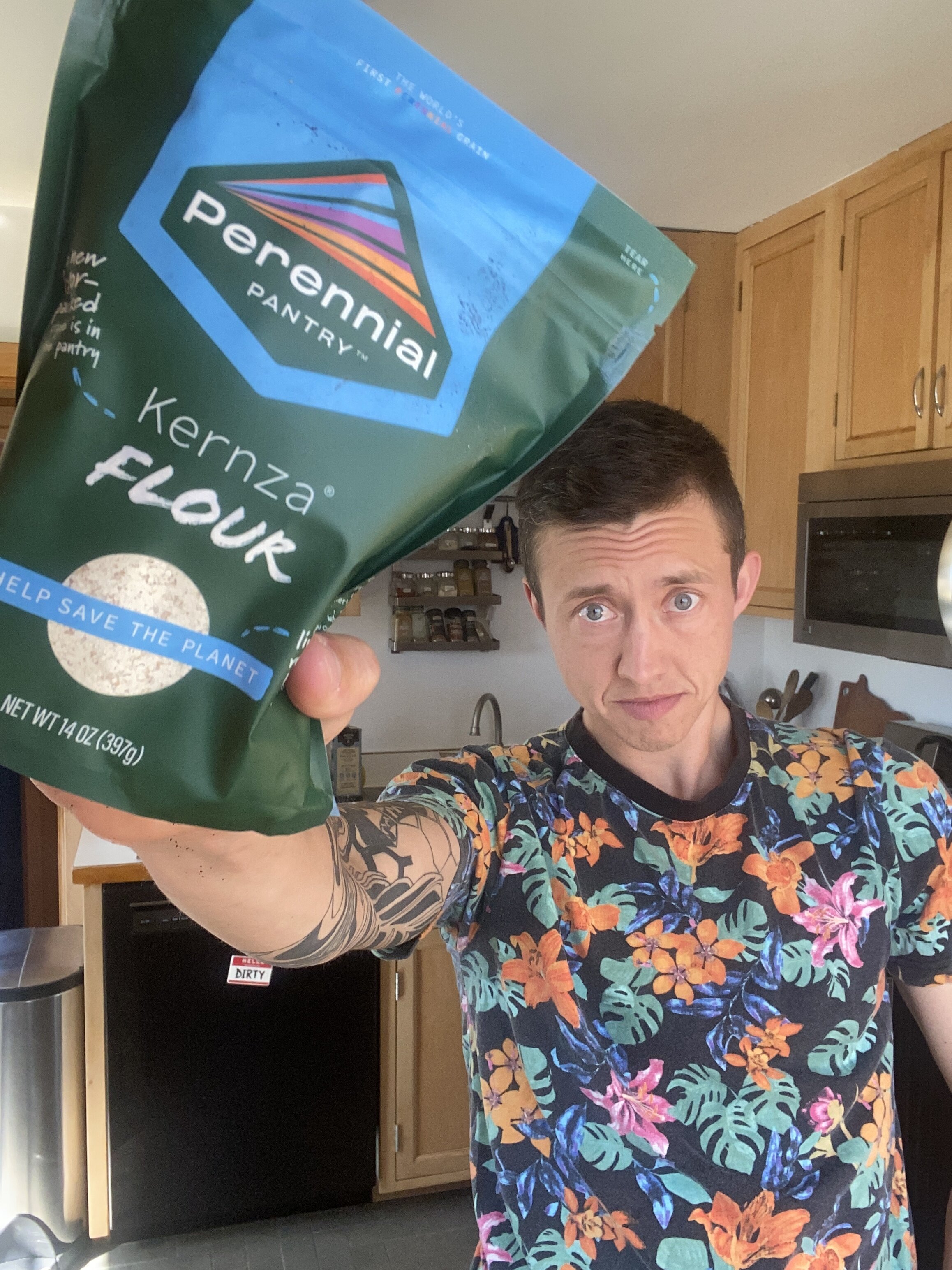

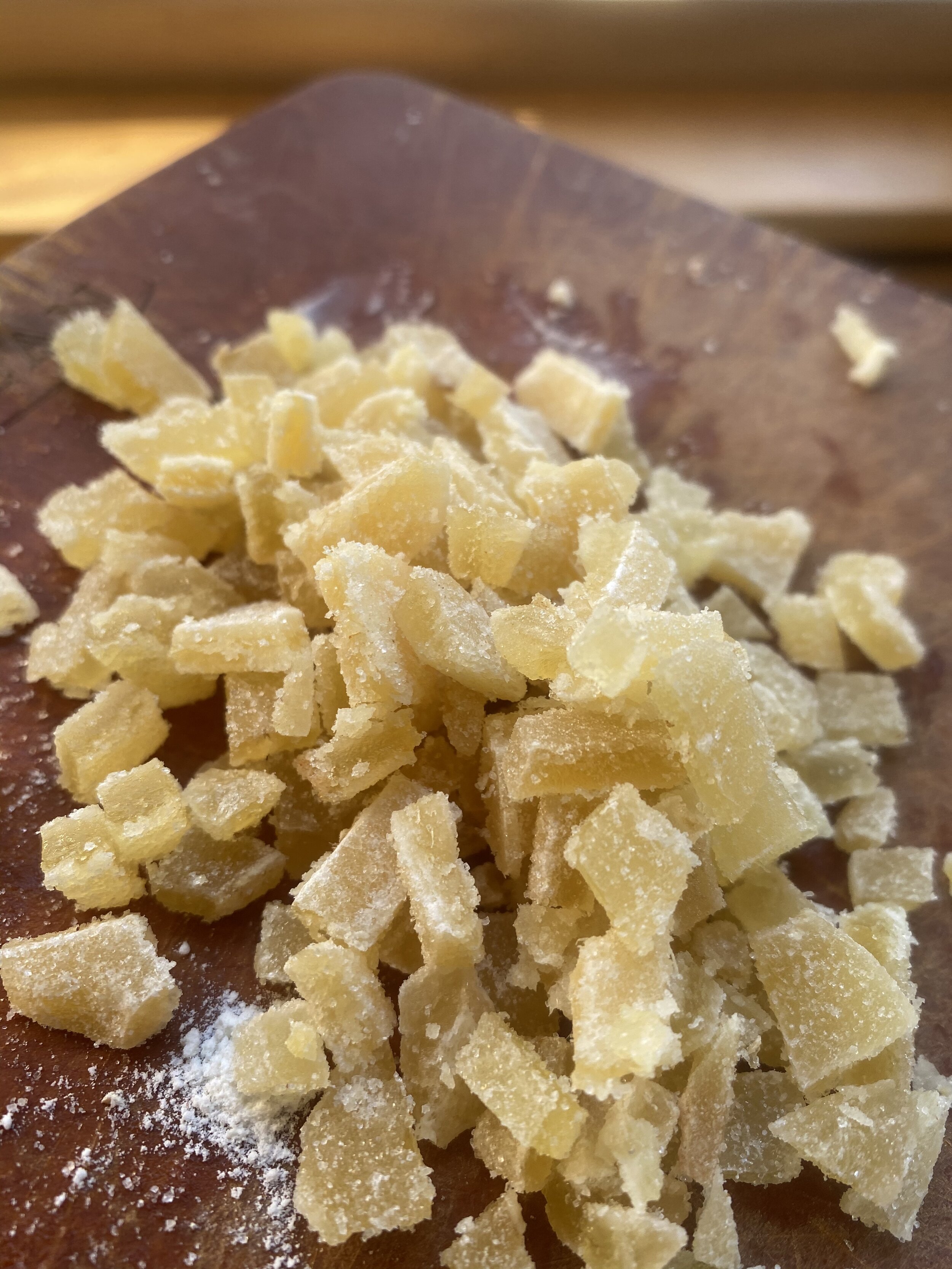
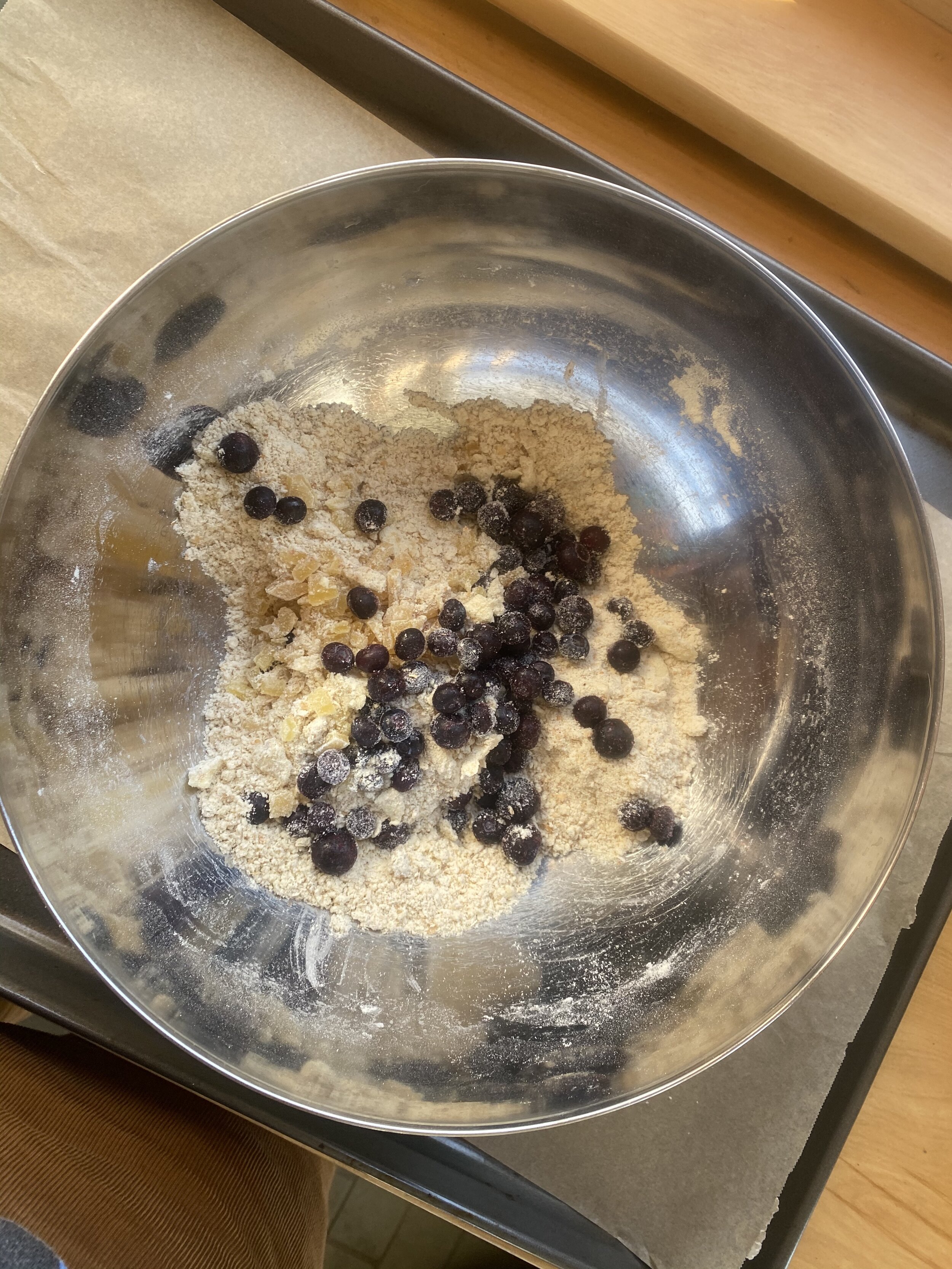


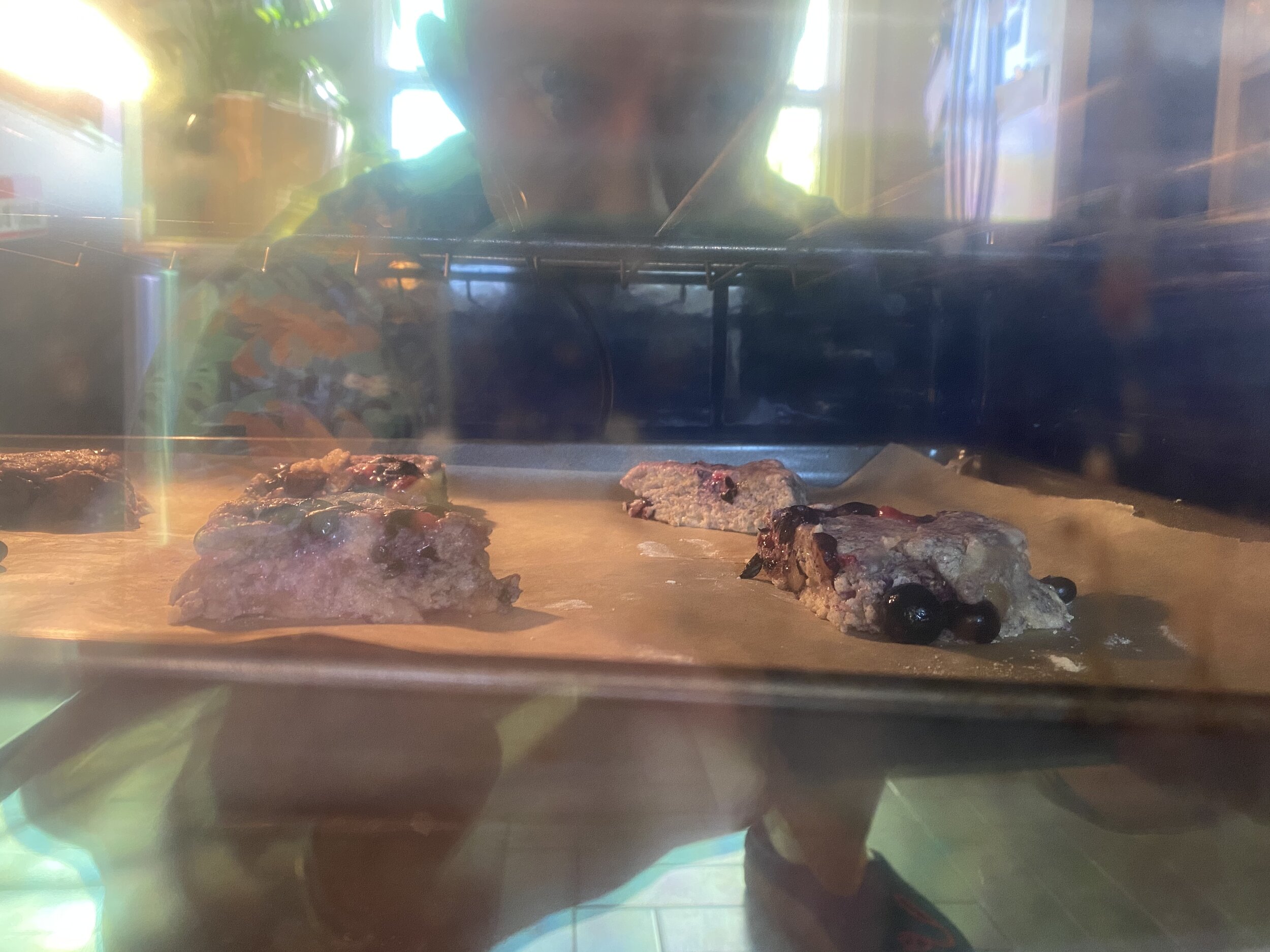


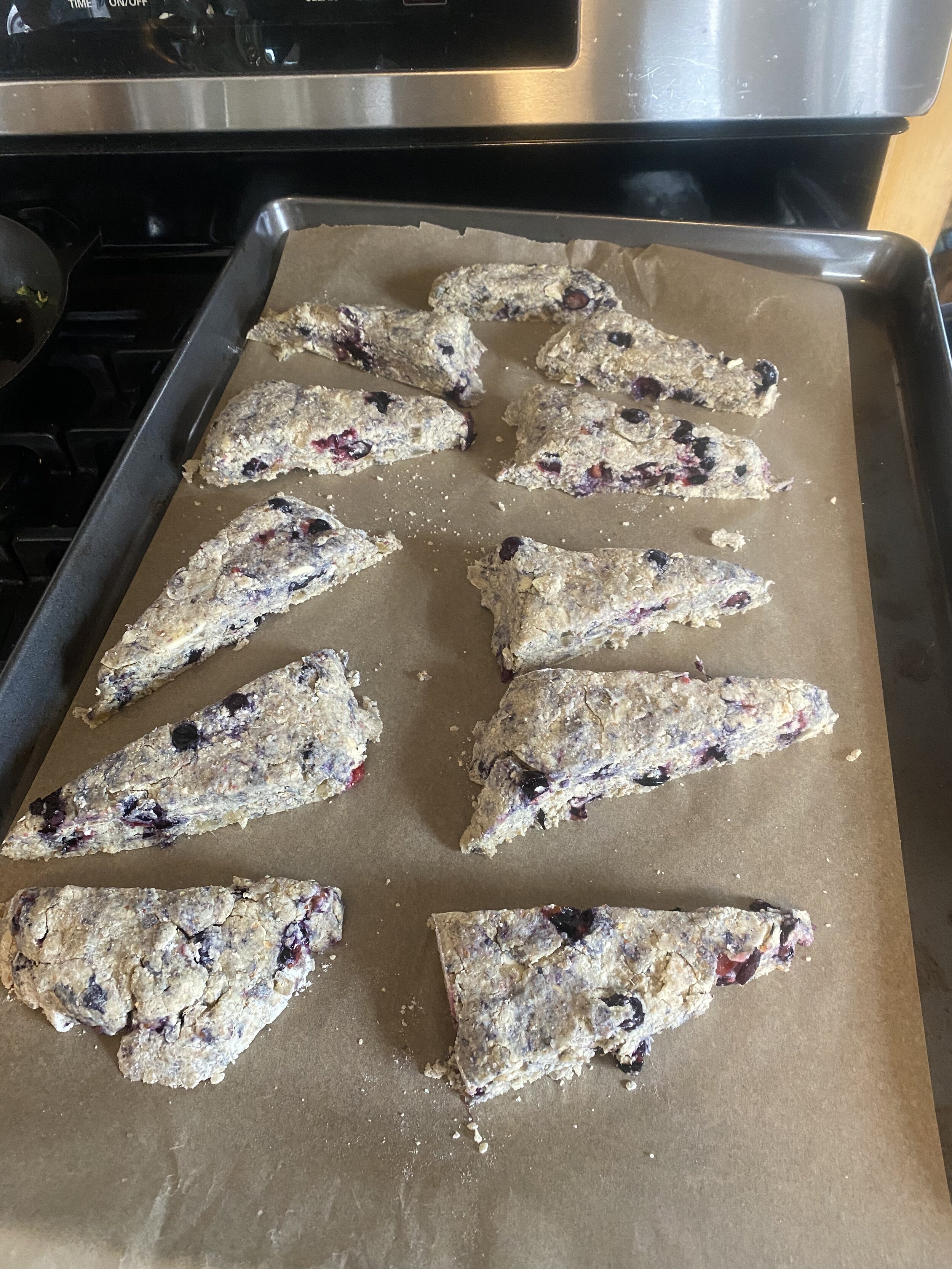
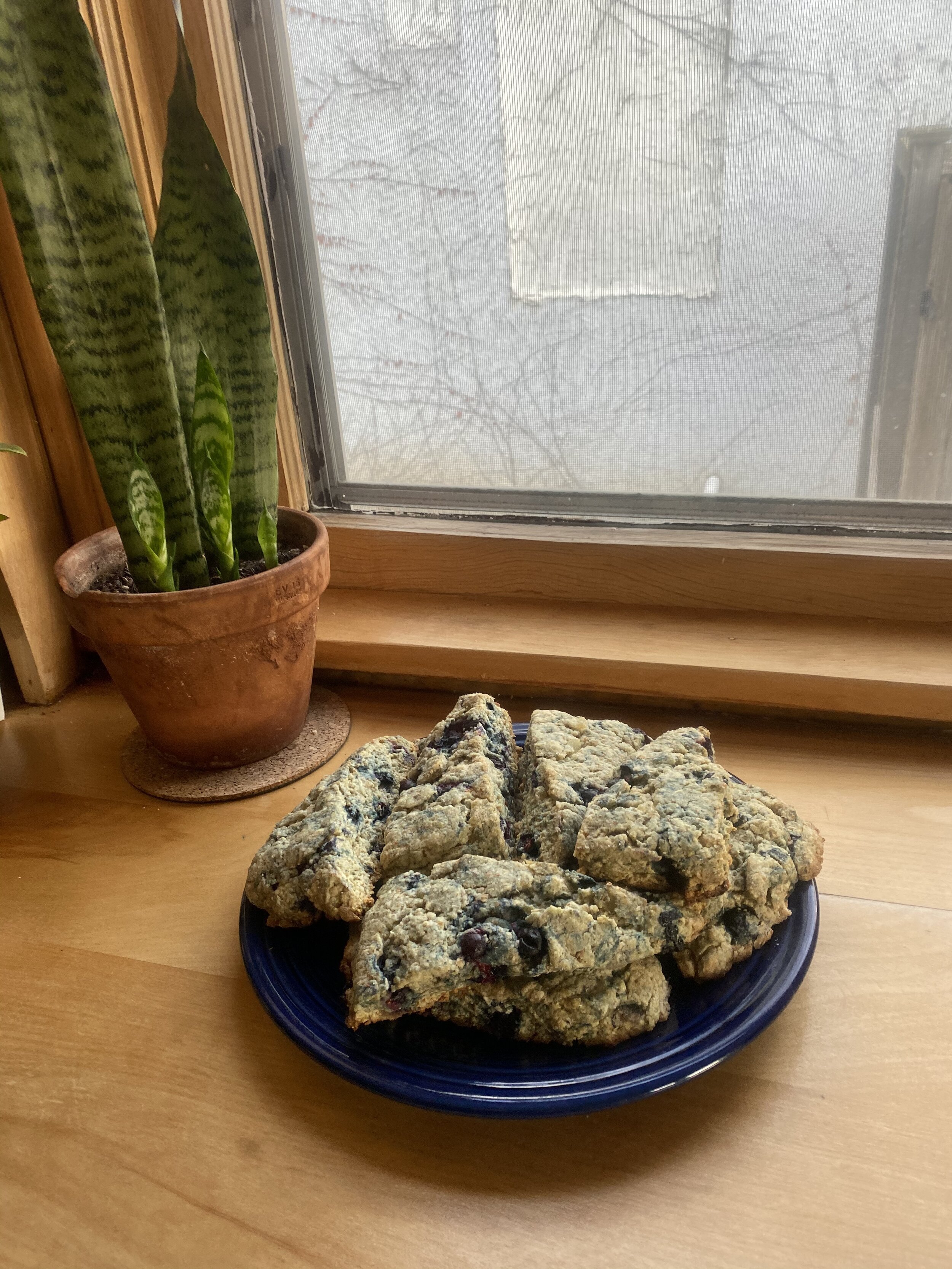
Earth Week Actions: Everybody can be a local water steward!
Lake Pepin serves as a catchbasin for sediment and other pollutants released throughout 48% of Minnesota, but local action is the first line of protection for this important stretch of the Mississippi River. Check out and commit to one or all of these actions, which include three ways to win a Kernza (R) prize package (cookbook + ingredients).
Read MoreHabitat Restoration: Delayed Until 2022
To our members and community,
The highly anticipated habitat restoration project near Bay City, Wisconsin almost made it through 2020 unscathed. But it is unfortunate now that the start date for construction has been pushed back until the spring of 2022. More than six years of work has gone into bringing this project to fruition, beginning with our advocacy in 2014. Needless to say, we share your frustration.
This past August, Lake Pepin Legacy Alliance (LPLA) attended the River Resources Forum - an interagency meeting for the Upper Mississippi River - where our partners projected to start construction next summer (2021). Over the last few months, a new timeline was put together to account for some unanticipated challenges. In short, our selection as 1 of 10 projects nationwide to be included in a federally funded pilot program has complicated planning efforts due to unclear implementation guidelines. The global pandemic has further reduced staff capacity within the Corps of Engineers. The good news is that once the design and engineering work is finally complete, we will have more federal dollars funding local restoration.
Assuming no further delays, the project is set to move forward in the spring of 2022. You can be sure that we will be watching closely the process over the next year to ensure all funds raised by LPLA (totaling $867,500) can be used as intended within the appropriate timeline. You can help by contacting your U.S. Representative to express your support for the project and ask them to protect against any additional delays:
LPLA’s leadership has paved the way for restoration to proceed by removing and mitigating obstacles (read: The Path to Habitat Restoration). Our ability to obtain the endorsement of local municipalities, state and federal legislators and our partner agencies show the irrefutable value of having a local voice about the river. We will continue as that voice. In the meantime, there is work to be done and we look forward to sharing the details of our strategic plan with you in early 2021. Thank you for helping us shape the future of Lake Pepin.
Rylee Hince
Executive Director, Lake Pepin Legacy Alliance
rylee@lakepepinlegacyalliance.org | 630-806-9909
